D Link DI725EVA1 Wireless G EVDO Router User Manual Manual 1
D Link Corporation Wireless G EVDO Router Manual 1
D Link >
Contents
- 1. Manual 1
- 2. Manual 2
- 3. CN25248 revised manual
Manual 1
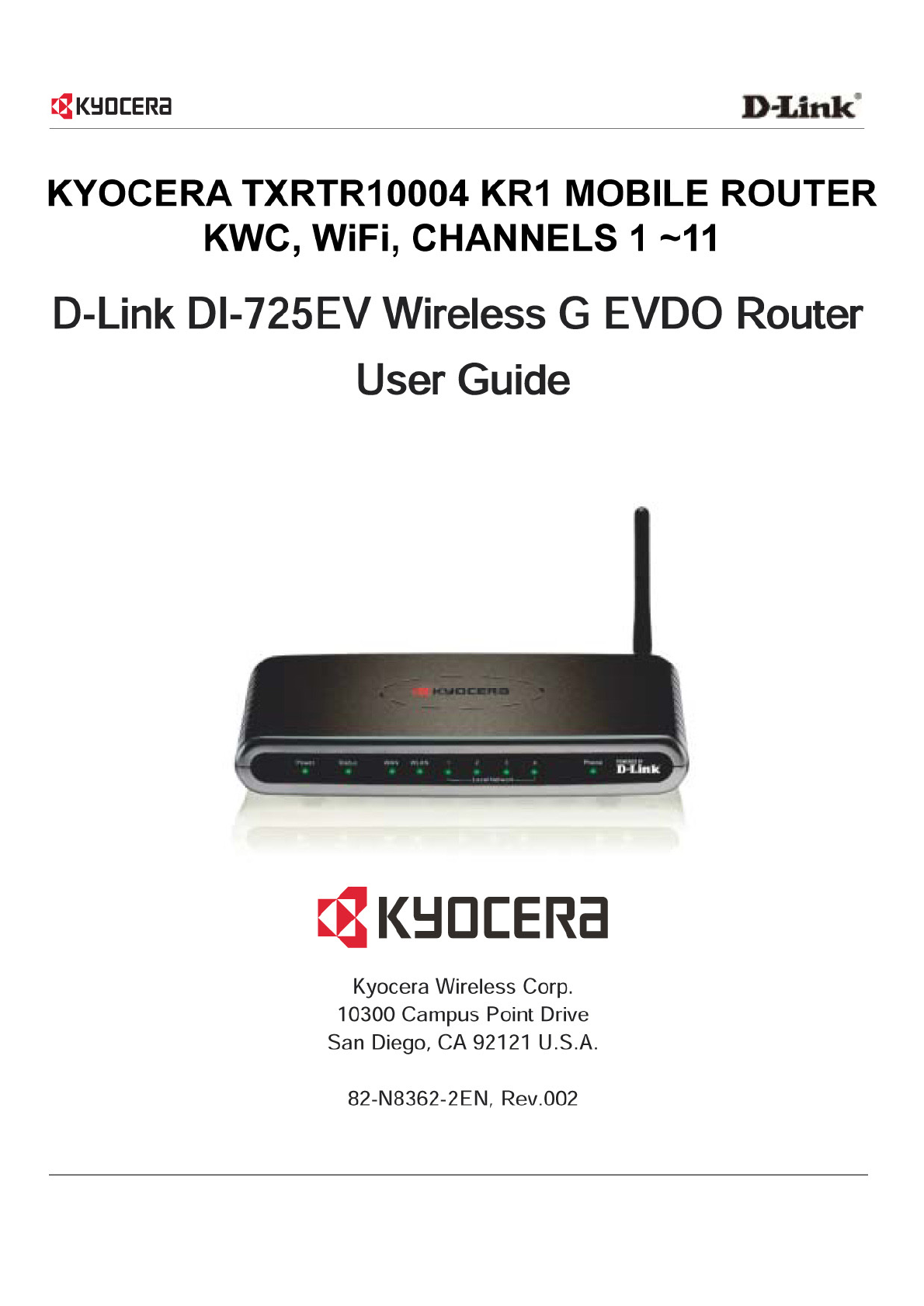
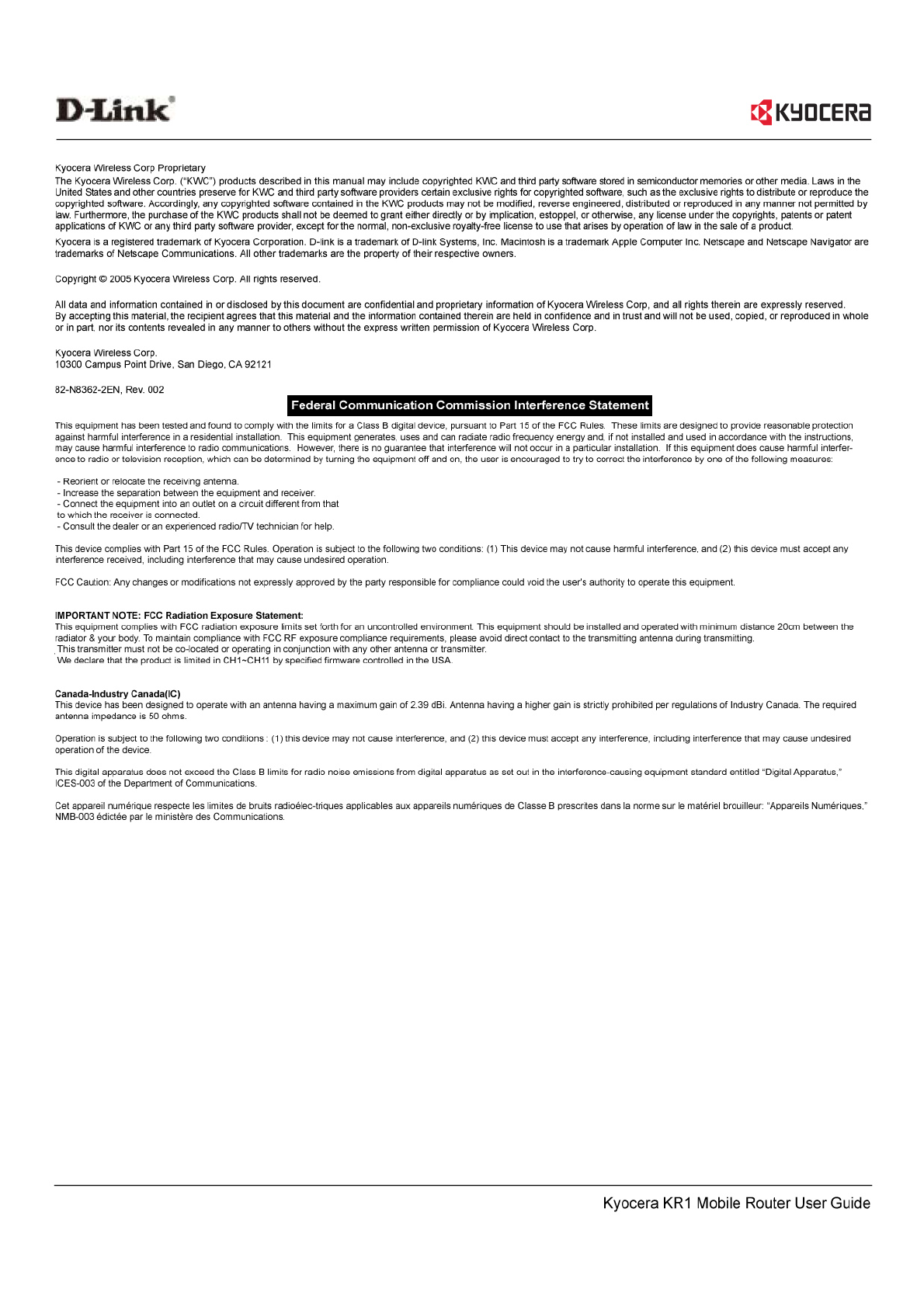

iii
Table of Contents
1 Introduction ................................................................................................................1
Connections–Kyocera KR1 Mobile Router (Back View) .................................................................................. 1
LEDs–Kyocera KR1 Mobile Router (Front View) ............................................................................. 2
Features ........................................................................................................................................... 2
2 Package Contents ......................................................................................................4
System Requirements for Configuration ..........................................................................................4
WiFi System Requirements ............................................................................................................................. 4
Verify Package Contents .................................................................................................................. 4
3 Wireless Basics ..........................................................................................................5
Standards-Based Technology .......................................................................................................... 5
Installation Considerations ............................................................................................................... 6
4 Installation Instructions.............................................................................................7
Connect the Kyocera KR1 Wireless Router to Your Network .......................................................................... 7
32-bit PCMCIA (EVDO) Card or 1xEV-DO Mobile Phone Connection ........................................................... 7
Establish WiFi Connection .............................................................................................................................. 7
5 Using the Configuration Menu ..................................................................................8
Basic > Wizard ................................................................................................................................................ 9
Basic > Wireless (Security–No Encryption) .................................................................................................. 10
Basic > Wireless (Security–WEP) ................................................................................................................. 11
Basic > Wireless (Security–WPA-PSK) ........................................................................................................ 12
Basic > WAN (EVDO) > WAN Type .............................................................................................................. 13
Basic > LAN .................................................................................................................................................. 14
Basic > DHCP .............................................................................................................................................. 15
Advanced > Virtual Server ........................................................................................................................... 16
Advanced > Applications ............................................................................................................................... 18
Advanced > Filters > IP Filters ...................................................................................................................... 19
Advanced > Filters > MAC Filters ................................................................................................................. 20
Advanced > Firewall ...................................................................................................................................... 21
Advanced > DMZ .......................................................................................................................................... 22
Advanced > Performance ............................................................................................................................. 23
Advanced > WAN (EVDO) ............................................................................................................................ 25
Tools > Admin ............................................................................................................................................... 26
Tools > Time ................................................................................................................................................. 27

iv Kyocera KR1 Mobile Router User Guide
Tools > System ............................................................................................................................................. 28
Tools > Firmware ......................................................................................................................................... 29
Tools > DDNS ............................................................................................................................................... 30
Tools > Misc .................................................................................................................................................. 31
Tools > Cable Test ........................................................................................................................................ 32
Status > Device Info ...................................................................................................................................... 33
Status > Log .................................................................................................................................................. 34
Status > Log > Log Settings #2 ..................................................................................................................... 35
Status > Log > Log Settings #3...................................................................................................................... 36
Status > Stats ............................................................................................................................................... 37
Help > Help Menu ......................................................................................................................................... 38
6 Troubleshooting .......................................................................................................39
I am unable to access the Configuration Menu when I use my computer
to configure the router. Why? ......................................................................................................................... 39
My wireless client cannot access the Internet. What should I do? ................................................................ 41
What variables may cause my wireless products to lose reception? ............................................................ 41
Why does my wireless connection keep dropping? ...................................................................................... 41
I am unable to achieve a wireless connection. Why? ................................................................................... 42
I forgot my encryption key. What should I do? .............................................................................................. 42
How do I reset my Kyocera KR1 Mobile Router to its factory default settings? ............................................ 43
What is VPN? ................................................................................................................................................ 43
What can I do if my Ethernet cable does not work properly? ........................................................................ 44
7 Technical Support ....................................................................................................45
Technical Support .......................................................................................................................... 45
Kyocera Accessories ...................................................................................................................... 45
8 Technical Specifications .........................................................................................46
9 Consumer Limited Warranty (USA only)................................................................48
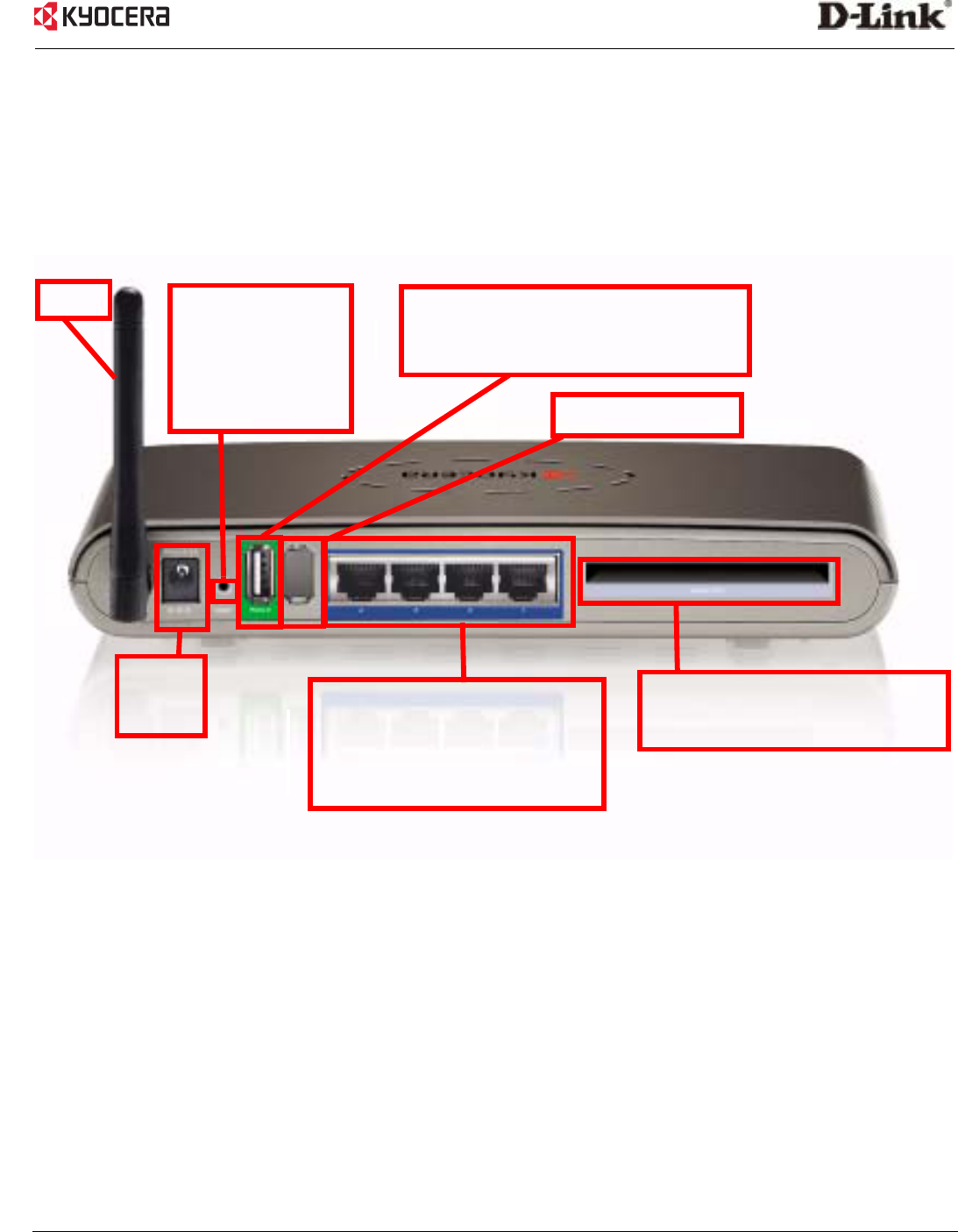
Introduction 1
1 Introduction
The Kyocera KR1 Mobile Router is a high-performance tool that supports wireless networking at home, work, or in
a public place. The Kyocera KR1 Mobile Router supports uses a 32-bit PCMCIA (EVDO) wireless card, or a 1xEV-DO
mobile phone, and supports wireless data transfers up to 54 Mbps, and wired data transfers up to 100 Mbps.
The Kyocera KR1 Mobile Router is compatible with industry security features.
Connections–Kyocera KR1 Mobile Router (Back View)
Note: The Kyocera KR1 Mobile Router contains two ports: a “Phone-In” USB Port, and a second internal diagnostic
port. Please use only the “Phone In” USB port for your 1xEV-DO WAN connections.
The second port is not for customer use. Please do not attempt to use this port.
WAN (EVDO) 32-bit PCMCIA Card Slot
Use this slot if a 32-bit PCMCIA card is
used for your WAN connection.
Receptor
for Power
Adapter
Phone In USB Port
Use the Phone In USB Port if a 1xEV-DO
mobile phone is your WAN connection.
LAN Ports
These ports automatically sense
the cable type when connecting to
Ethernet-enabled computers.
These are Auto MDI/MDIX ports.
Reset Button
Press this button to
restore the KR1 to
its original factory
default setting.
Internal Diagnostic Port
Antenna
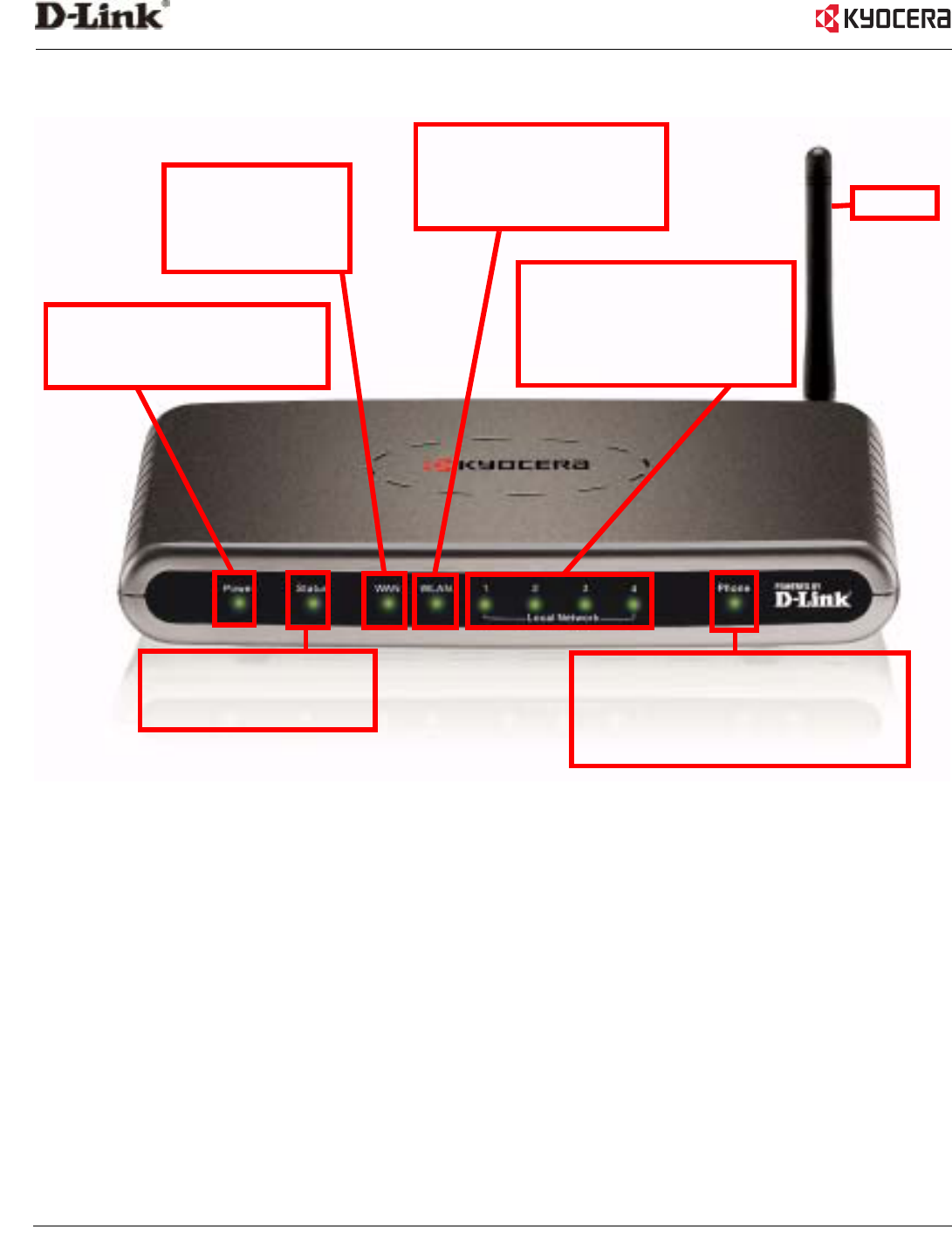
2 Kyocera KR1 Mobile Router User Guide
LEDs–Kyocera KR1 Mobile Router (Front View)
Features
• When used with either 802.11b, or 802.11g, security features include WPA-PSK:Pre Shared Key Mode.
This mode utilizes a single Passphrase of eight to 63 ASCII characters to authenticate users.
• Fully compatible with the 802.11g standard to provide a wireless data transfer rate of up to 54Mbps.
• Backwards compatible with the 802.11b standard to provide a wireless data rate of up to 11Mbps.
• Utilizes OFDM technology (Orthogonal Frequency Division Multiplexing).
• User-friendly configuration and diagnostic utilities.
• Operates in the 2.4GHz frequency range.
• Advanced Firewall features.
• Supports NAT with VPN pass-through, providing added security.
•MAC Filtering
• IP Filtering
•Port Scheduling
WAN LED
A green light indicates
connection on the
(EVDO) port.
WLAN LED
A blinking green light indicates
that the connection on the
WLAN interface is available.
PHONE LED
A green light indicates connection to the
USB port (used when a 1xEV-DO mobile
phone is your WAN connection).
STATUS LED
A green light indicates the
KR1 is ready.
LOCAL NETWORK LEDs
A green light indicates a
connection to an Ethernet-enabled
computer (ports 1-4). This LED
blinks during data transmission.
POWER LED
A green light indicates
connection to the power supply.
ANTENNA

Introduction 3
• DHCP server enables all networked computers to automatically receive IP addresses.
• Web-based interface for Managing and Configuring.
• Access Control to manage users on the network.
• Supports special applications that require multiple connections.
• Equipped with 4 10/100 Ethernet ports, 1 USB phone port, and 1 WAN (EVDO) 32-bit PCMCIA Card Slot.
• Connects multiple computers to a Broadband (EVDO) modem to share the Internet connection.
Note: The Kyocera KR1 Mobile Router is designed to work with EVDO-capable handsets that can be used as a
modem (support tethered data). Please refer to your service provider for detailed feature information. Support
is also available at http://www.kyocera-wireless.com/support.

4
2 Package Contents
System Requirements for Configuration
• A compatible 32-bit PCMCIA (EVDO) card with service, or a 1xEV-DO mobile phone with service.
• Computers with Windows, Macintosh, or Linux-based operating systems with an installed
Ethernet adapter.
• Internet Explorer version 6.0 or Netscape Navigator version 7.0 and above.
WiFi System Requirements
• A 802.11b, or 802.11g Adapter
Verify Package Contents
The Kyocera KR1 Mobile Router package should contain the items listed below. If any of the items are missing,
please contact your reseller.
• Kyocera KR1 Mobile Router
•Kyocera KR1 Mobile Router User Guide (CD-ROM)
•Kyocera KR1 Mobile Router Quick Installation Guide
• Ethernet patch cable (CAT5 UTP)
• Mounting Kit
• Antenna
• DC 5V, 3.0A Power Adapter
• AC Power Cord
Caution: Using a power supply with a different voltage rating than the one included with the Kyocera KR1 Mobile
Router will cause damage and void the warranty for this product.

Wireless Basics 5
3 Wireless Basics
The Kyocera KR1 Mobile Router is based on industry standards to provide easy-to-use and compatible high-speed
wireless connectivity within your home, or business. The Kyocera KR1 Mobile Router allows you to access the data
you want, when and where you want it.
A WLAN (wireless local area network) transmits and receives data with radio signals instead of wires. WLANs are
used increasingly in both home and office environments, and public areas such as airports, coffee shops, and
universities. Innovative ways to utilize WLAN technology are helping people to work and communicate more
efficiently. Increased mobility, and the absence of cabling and other fixed infrastructure, have proven beneficial for
many users.
Wireless users can use the same applications as those on a wired network. Wireless adapter cards for laptop and
desktop systems support the same protocols as Ethernet adapter cards.
People use wireless LAN technology for many different purposes:
Mobility - Productivity increases when people have access to data in any location within the operating range of the
WLAN. Management decisions based on real-time information can significantly improve worker efficiency.
Low Implementation Costs - WLANs are easy to set up, manage, change, and relocate. Networks that frequently change
can benefit from WLANs ease of implementation. WLANs can operate in locations where installation of wiring may
be impractical.
Installation and Network Expansion - Installing a WLAN system can be fast and easy, and eliminate the need to pull
cable through walls and ceilings. Wireless technology allows the network to go where wires cannot go - even
outside the home or office.
Inexpensive Solution - Wireless network devices are as competitively priced as conventional
Ethernet network devices.
Standards-Based Technology
The Kyocera KR1 Mobile Router utilizes the 802.11g standard.
The IEEE 802.11g standard is an extension of the 802.11b standard. It increases the data rate up to 54Mbps within
the 2.4GHz band, utilizing OFDM technology.
This means that in most environments, within the specified range of this device, you can transfer large files quickly
or even watch a movie in MPEG format over your network without noticeable delays. This technology works by
transmitting high-speed digital data over a radio wave utilizing OFDM (Orthogonal Frequency Division Multiplexing)
technology. OFDM splits the radio signal into multiple smaller sub-signals that transmit simultaneously at different
frequencies to the receiver. OFDM reduces the amount of crosstalk (interference) in signal transmissions.
The Kyocera KR1 Mobile Router is backwards compatible with 802.11b devices. This means that if you have an
existing 802.11b network, the devices in that network are compatible with 802.11g devices at speeds of up to
11Mbps in the 2.4GHz range.

6 Kyocera KR1 Mobile Router User Guide
Installation Considerations
The Kyocera KR1 Mobile Router allows you access your network using a wireless connection, from virtually
anywhere within its operating range. Keep in mind however, that the number, thickness, and location of walls,
ceilings, or other objects that the wireless signals must pass through, may limit this range.
Typical ranges vary depending on the types of materials used, and background RF (radio frequency) noise in your
home or business.
To maximize your wireless range, please follow these guidelines:
1. Keep the number of walls and ceilings between the Kyocera KR1 Mobile Router and other network devices
to a minimum. Each wall or ceiling can reduce the Kyocera KR1 Mobile Router’s range from 3-90 feet
(1-30 meters).
Note: The same considerations apply to your broadband EVDO connection.
2. Keep your product aware from electrical devices (such as microwaves, air conditioners, and televisions) that
emit large quantities of RFI (Radio Frequency Interference).

Installation Instructions 7
4 Installation Instructions
Connect the Kyocera KR1 Wireless Router to Your Network
Note: Ensure that power to your Kyocera KR1 Mobile Router is not connected before performing the
installation steps below.
32-bit PCMCIA (EVDO) Card or 1xEV-DO Mobile Phone Connection
Note: To preserve the life of your phone’s battery, it is recommended that you use your phone’s charging
cradle when connected to the Kyocera KR1 Mobile Router.
1. Attach the antenna.
a. Remove the antenna from its plastic wrapper.
b. Screw the antenna in a clockwise direction to the back panel of the unit.
c. Once secured, position the antenna upward at its connecting joint. This will ensure optimal reception.
2. Connect a compatible 32-bit PCMCIA (EVDO) card with service, or 1xEV-DO mobile phone with service, to
the Kyocera KR1 Mobile Router in one of the following ways:
a. Insert your wireless 32-bit PCMCIA (EVDO) card into the WAN (EVDO) 32-bit PCMCIA Card Slot, or
b. Connect your wireless 1xEV-DO mobile phone to the “Phone In” jack, with your USB phone cable.
Note: The Kyocera KR1 Mobile Router is designed to work with EVDO-capable handsets that can be used as
a modem (support tethered data). Please refer to your service provider for detailed feature
information. Support is also available at http://www.kyocera-wireless.com/support.
3. Insert the Ethernet patch cable into LAN Port 1 on the back panel of the Kyocera KR1 Mobile Router, and an
available Ethernet port on the network adapter in the computer you will use to configure the unit.
Note: The Kyocera KR1 Mobile Router LAN Ports are “Auto-MDI/MDIX.” This provides either patch or
crossover Ethernet cable LAN Port access.
4. Connect the power adapter to the receptor on the back panel of your Kyocera KR1 Mobile Router.
Then plug the other end of the power adapter into a wall outlet or power strip.
a. The Power LED will turn ON to indicate power has been applied.
b. Other LEDs will flash ON and OFF as the Kyocera KR1 Mobile Router performs initialization and Internet
connection processes. This will take a few minutes.
c. When complete, the following LEDs will illuminate green: Power, Status, WAN, WLAN, and LAN Port 1
(or your specific LAN Port connection).
Note: For 1xEV-DO Phone Users if you have connected a 1xEV-DO mobile phone to your Kyocera KR1 Mobile
Router, the Phone LED will also illuminate green.
Establish WiFi Connection
If you selected either WEP or WPA-PSK encryption, ensure these settings match your WiFi adapter settings.
WiFi and encryption settings must match for access to the Kyocera KR1 Mobile Router Configuration Menu, and the
Internet. Please refer to your WiFi adapter documentation for additional information.
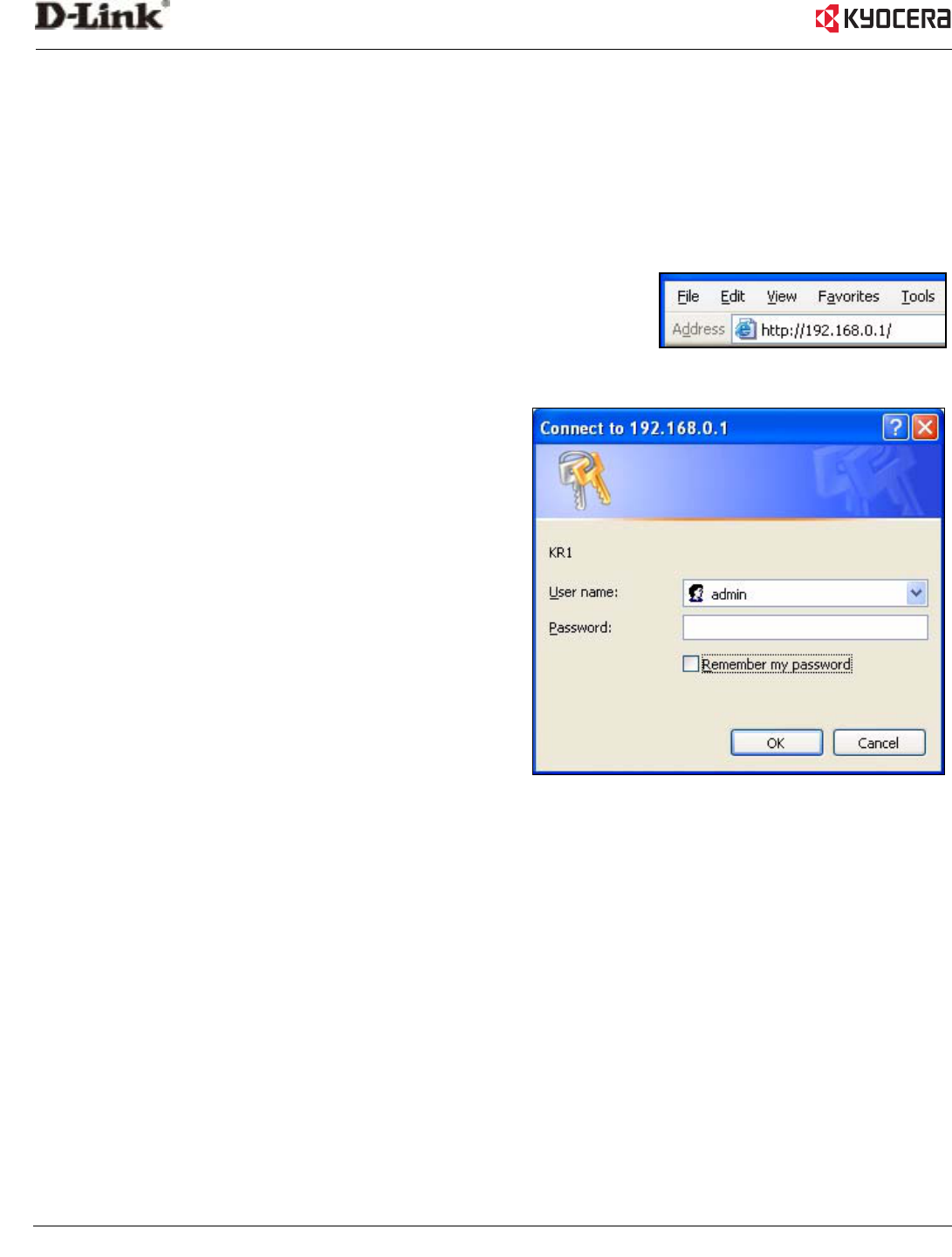
8 Kyocera KR1 Mobile Router User Guide
5 Using the Configuration Menu
Once properly configured, the Kyocera KR1 Mobile Router will obtain and assign IP address information
automatically. Configuration settings can be established through the Kyocera KR1 Mobile Router Configuration
Menu. You can access this interface by performing the steps listed below:
1. Open a web-browser to http://www.kyocera-wireless.com,
(or your favorite web browser).
2. Type in the IP Address of the Kyocera KR1 Mobile Router
(http://192.168.0.1)
Note: If you have changed the default IP Address assigned to the
Kyocera KR1 Mobile Router, ensure you enter the correct IP
Address now.
3. Type admin in the User Name field.
4. Leave the Password blank.
5. Click OK.

Using the Configuration Menu 9
Basic > Wizard
The Basic>Wizard Type screen will appear.
Refer to the Kyocera KR1 Mobile Router Quick
Installation Guide for more information
regarding the Setup Wizard.
These buttons appear on many of the
configuration screens in this section.
Please click on the appropriate button at the
bottom of each screen after you make a
configuration change.
Clicking Apply saves changes made to the page.
Clicking Cancel clears changes made to the page.
Clicking Help brings up helpful information regarding the page.
Clicking Restart restarts the router. (Necessary for some changes.)
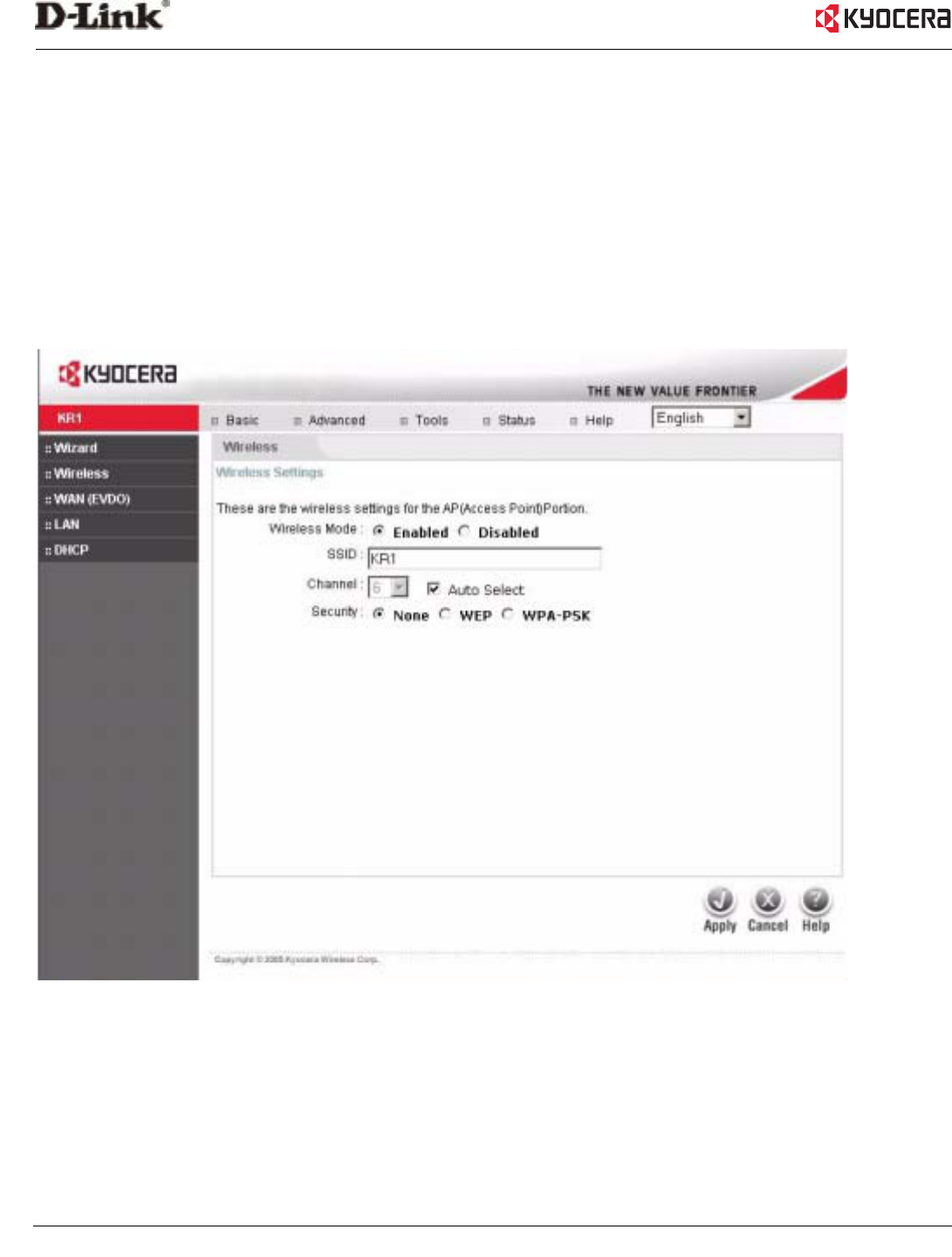
10 Kyocera KR1 Mobile Router User Guide
Basic > Wireless (Security–No Encryption)
Wireless Mode- Enabled is the default . Selecting this option will allow you to set your Wireless Access Point (WAP)
settings. Selecting Disabled, will grey-out all Security radio buttons (please see “Security” below).
SSID- Service Set Identifier (SSID) is the name designated for a specific wireless local area network (WLAN).
The SSID's factory default setting is KR1. The SSID can be easily changed to establish a new wireless network.
(Note: SSID names may contain up to 32 ASCII characters).
Channel- Auto Select is the default . Devices on the network must share the same channel. (Note: Wireless adapters
automatically scan and match the wireless settings. You may also select the channel you wish to use).
Security- You may select from three levels of encryption to secure your wireless network:
No Encryption, WEP, or WPA-PSK.
Security- No Encryption is the default (as shown in the screen above).
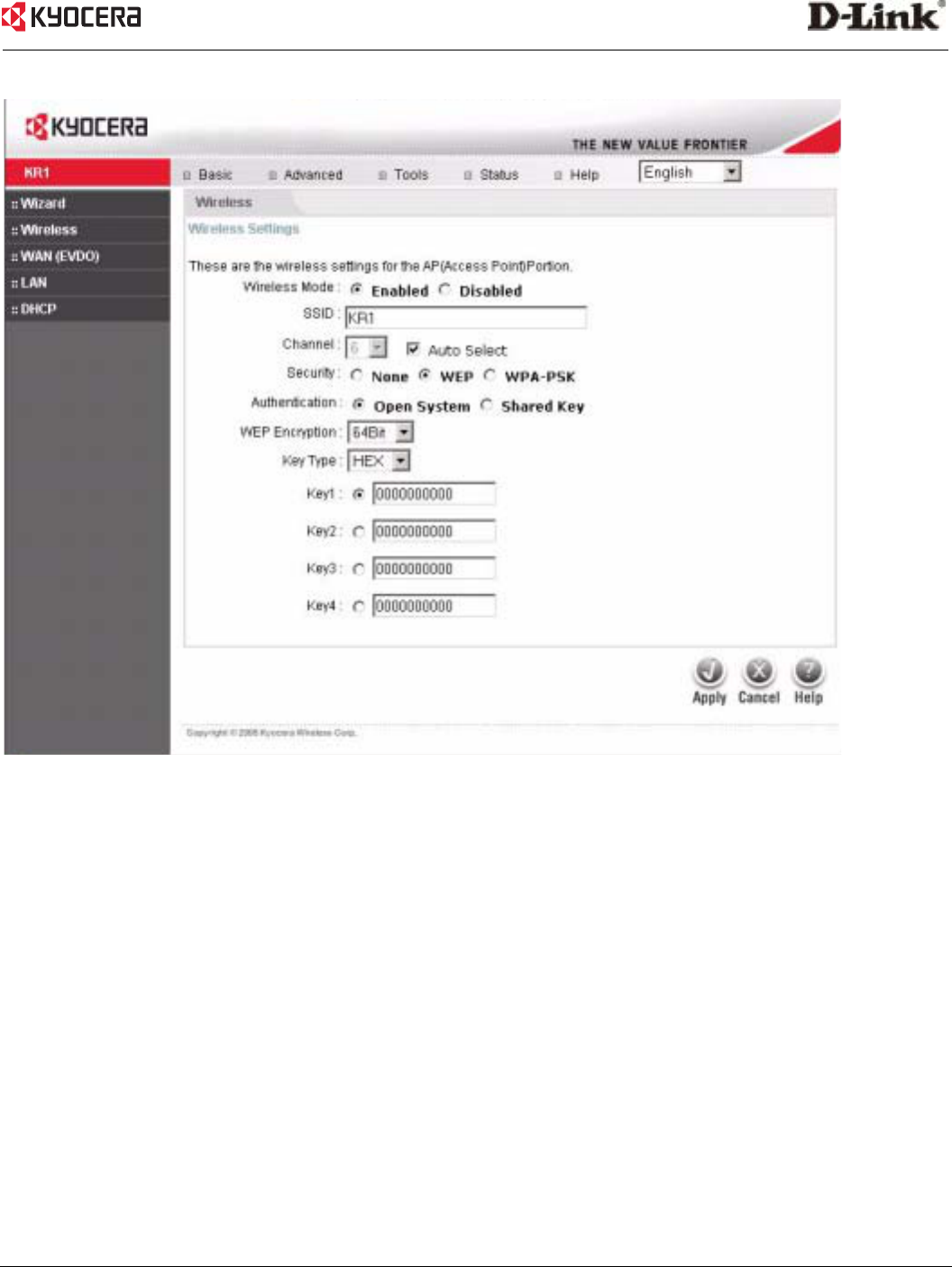
Using the Configuration Menu 11
Basic > Wireless (Security–WEP)
Security- WEP
Authentication- You may select Open System, or Shared Key. The default is Open System. If you select Open System, your
network will not be secure. Select Shared Key to create a secure network authentication between your WLAN host
and the Kyocera KR1 Mobile Router. To enable this setting, provide a ten-character (alpha-numeric) key in the
ASCII Key field.
WEP Encryption- Two levels or wireless encryption are available: 64-bit, and 128 bit. You may change the encryption
setting for a more secure wireless connection.
Key Type- Select 4HEX or ASCII.
Key1-Key4- Input up to 4 WEP keys; select the one you want to use.
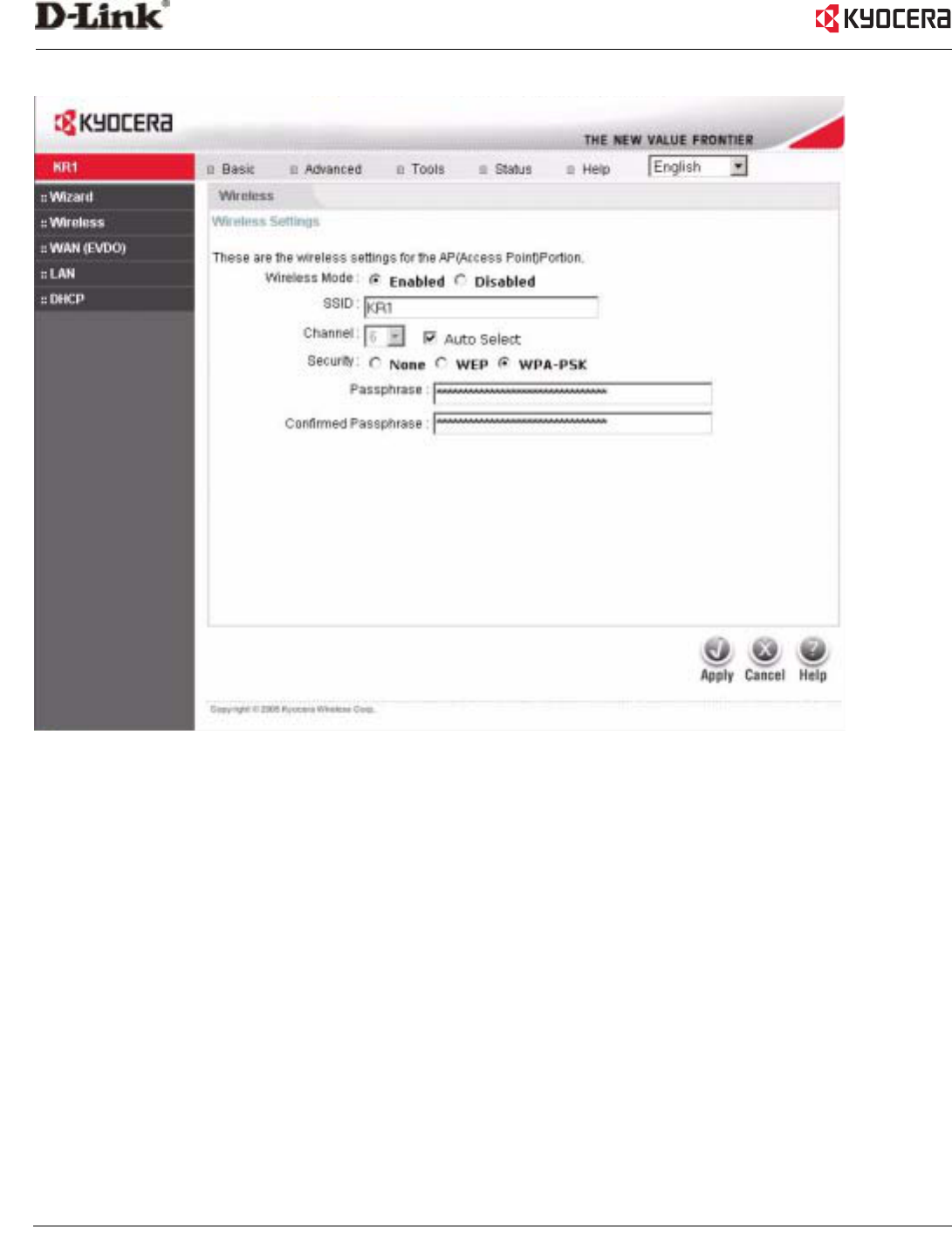
12 Kyocera KR1 Mobile Router User Guide
Basic > Wireless (Security–WPA-PSK)
Security- WPA-PSK.
WPA-PSK authenticates users based on a Passphrase. The default setting does not contain a Passphrase.
Passphrase- To enable your WPA-PSK, enter your eight to 63 alpha-numeric Passphrase.
Confirm Passphrase- Enter your Passphrase again to secure your wireless network.
Note: Some older WiFi adapters may not support WPA-PSK.
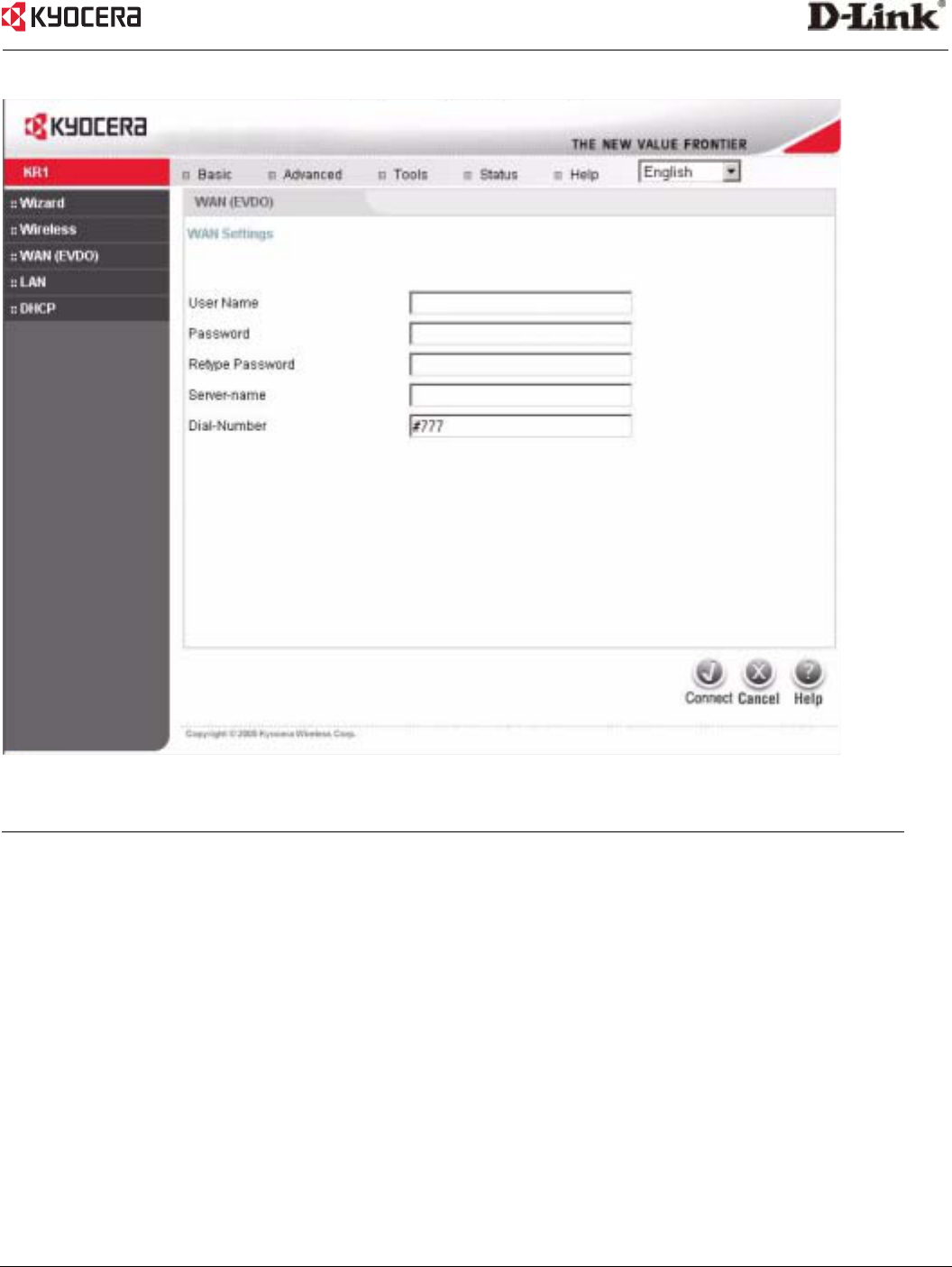
Using the Configuration Menu 13
Basic > WAN (EVDO) > WAN Type
Caution for WAN (EVDO) Networking: The WAN (EVDO) fields will be populated by your EVDO card.
Ensure that you do not alter these settings or EVDO service could be disrupted.
Please refer to your EVDO documentation, or service provider information for additional information.
User Name- Please do not alter this setting.
Password- Please do not alter this setting.
Retype Password- Please do not alter this setting.
Server-name- Please do not alter this setting.
Dial Number- The default is #777. This field is populated by your EVDO card.
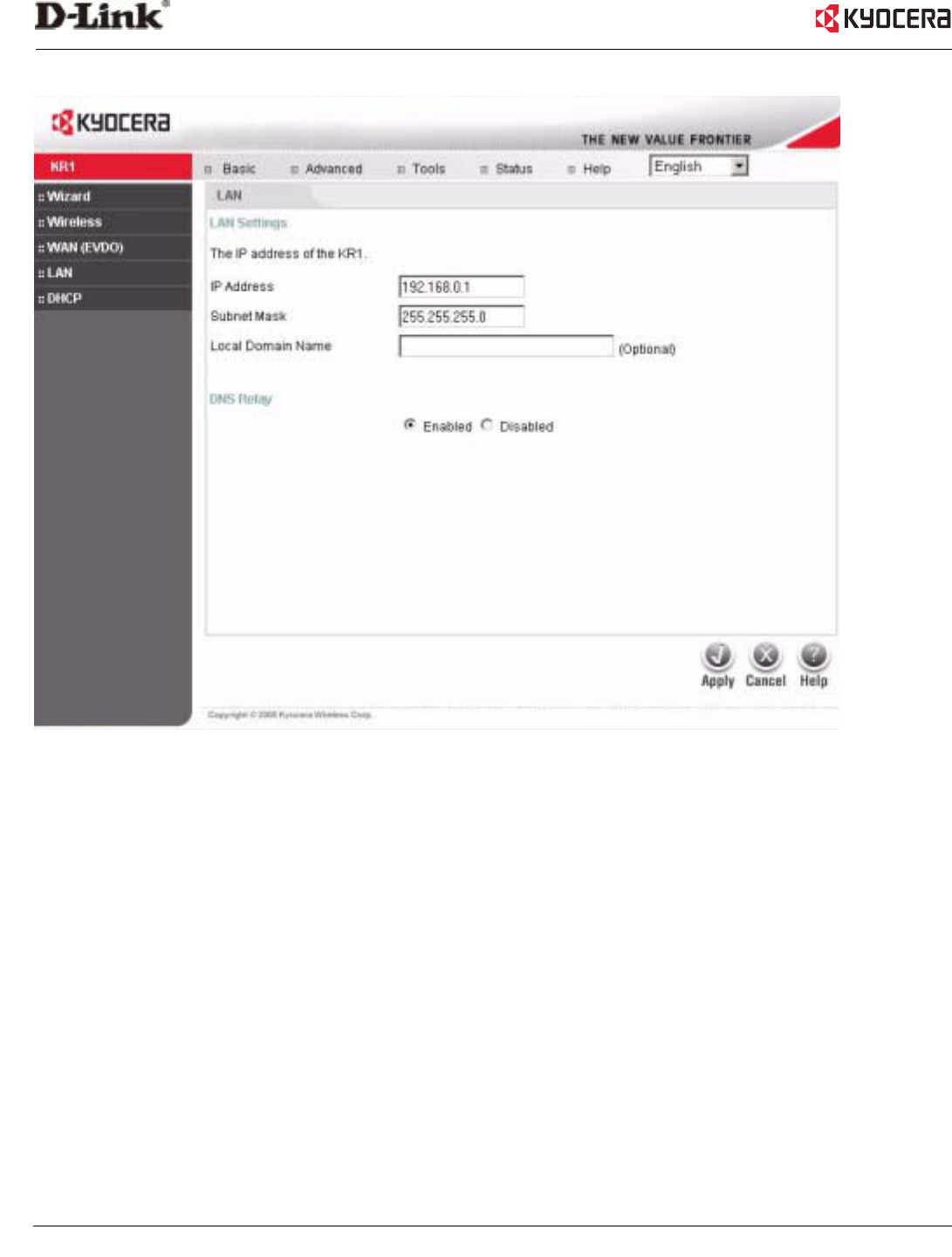
14 Kyocera KR1 Mobile Router User Guide
Basic > LAN
LAN is short for Local Area Network, and is considered your internal network. These are the IP settings of the LAN
interface for the Kyocera KR1 Mobile Router, and they may be referred to as Private settings. You may change the
LAN IP address if needed. The LAN IP address is private to your internal network and cannot be seen on
the Internet.
Note: There are 254 addresses available on the Kyocera KR1 Mobile Router when using a 255.255.255.0 (Class C)
subnet. Example: The router's IP address is 192.168.0.1. The available client IP range is 192.168.0.2 through
192.168.0.254.
IP Address- The IP address of the LAN interface. The default IP address is: 192.168.0.1
Subnet Mask- The subnet mask of the LAN interface. The default subnet mask is 255.255.255.0
Local Domain- This field is optional. Enter in the local domain name.
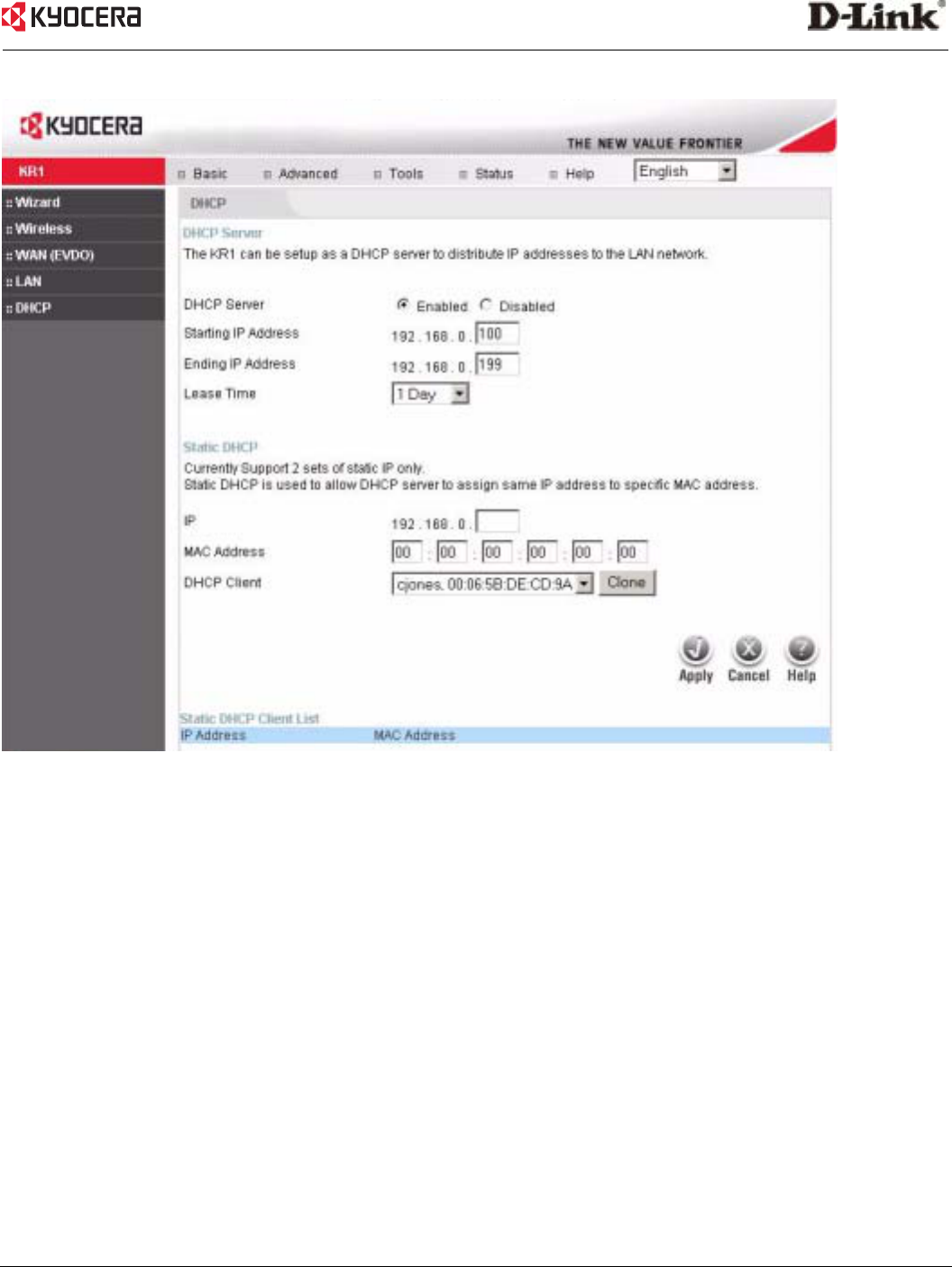
Using the Configuration Menu 15
Basic > DHCP
DHCP stands for Dynamic Host Control Protocol. The Kyocera KR1 Mobile Router has a built-in DHCP server, which
automatically assigns an IP address to the computers on the LAN/private network. Be sure to set your computers to
be DHCP clients by setting their TCP/IP settings to "Obtain an IP Address Automatically." When you turn your
computers on, they automatically load the proper TCP/IP settings provided by the Kyocera KR1 Mobile Router. The
DHCP Server automatically allocates an unused IP address from the IP address pool to the requesting computer. You
must specify the starting and ending address of the IP address pool.
DHCP Server- Select Enabled or Disabled. The default setting is Enabled.
Starting IP Address- The starting IP address for the DHCP server's IP assignment.
Ending IP Address- The ending IP address for the DHCP server's IP assignment.
Lease Time- The length of time for the IP lease. Enter the Lease time. The default setting is one day.
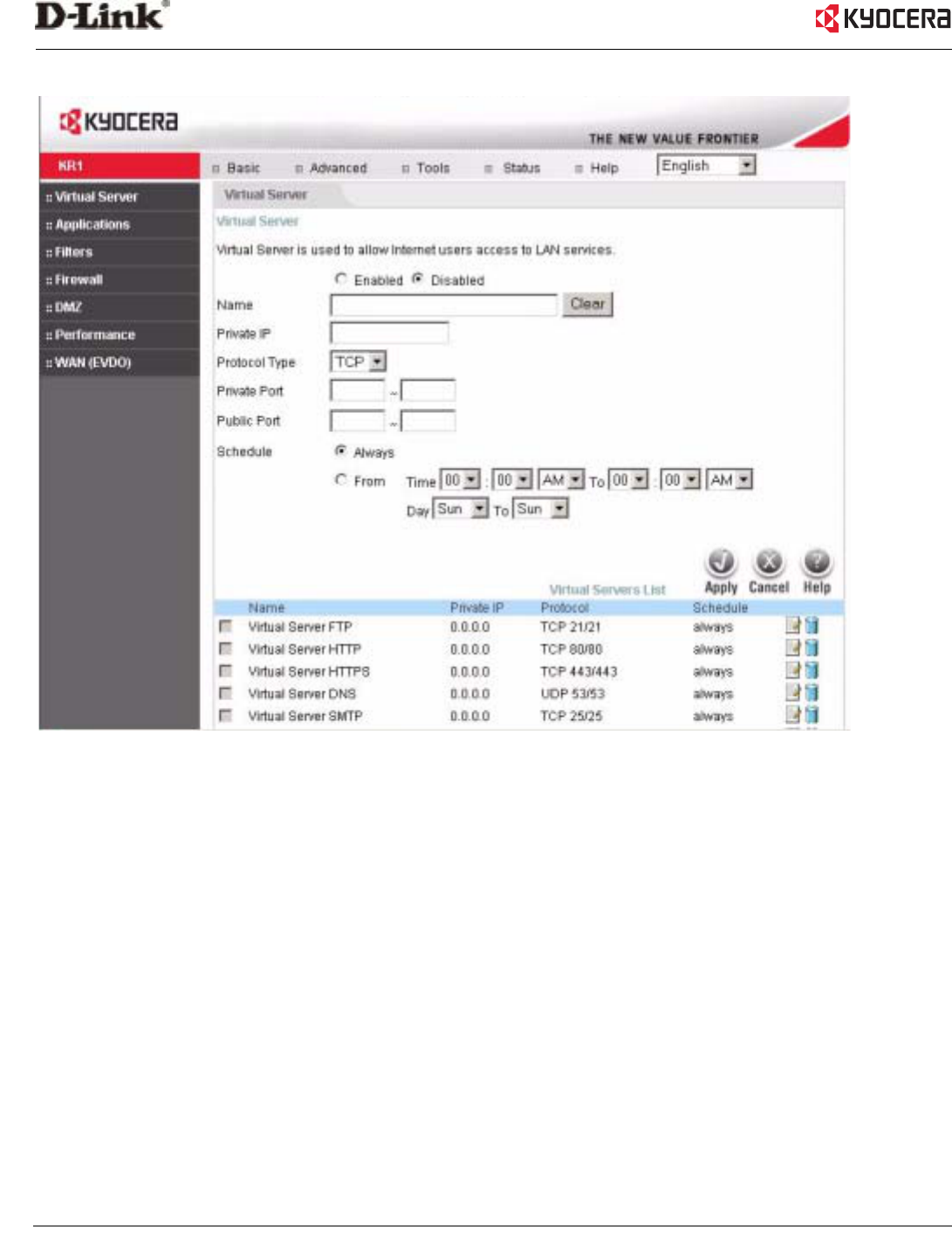
16 Kyocera KR1 Mobile Router User Guide
Advanced > Virtual Server
The Kyocera KR1 Mobile Router can be configured as a virtual server so that remote users accessing Web or FTP
services via the public IP address can be automatically redirected to local servers in the LAN (Local Area Network).
The Kyocera KR1 Mobile Router firewall feature filters out unsolicited packets to protect your LAN network so all
computers networked with the Kyocera KR1 Mobile Router are invisible to the outside world. If you wish, you can
make some of the LAN computers accessible from the Internet by enabling Virtual Server. Depending on the
requested service, the Kyocera KR1 Mobile Router redirects the external service request to the appropriate server
within the LAN network.
The Kyocera KR1 Mobile Router is also capable of port-redirection, meaning incoming traffic to a particular port
may be redirected to a different port on the server computer.
Each virtual service created is listed at the bottom of the screen in the Virtual Servers List. There are pre-defined
virtual services already in the table. You may use them by enabling them and assigning the server IP to use
that particular virtual service.
Virtual Server- Select Enabled or Disabled. The default setting is Disabled.
Name- Enter the name referencing the virtual service.
Private IP- The server computer in the LAN (Local Area Network) that provides the virtual services.
Protocol Type- The protocol used for the virtual service.
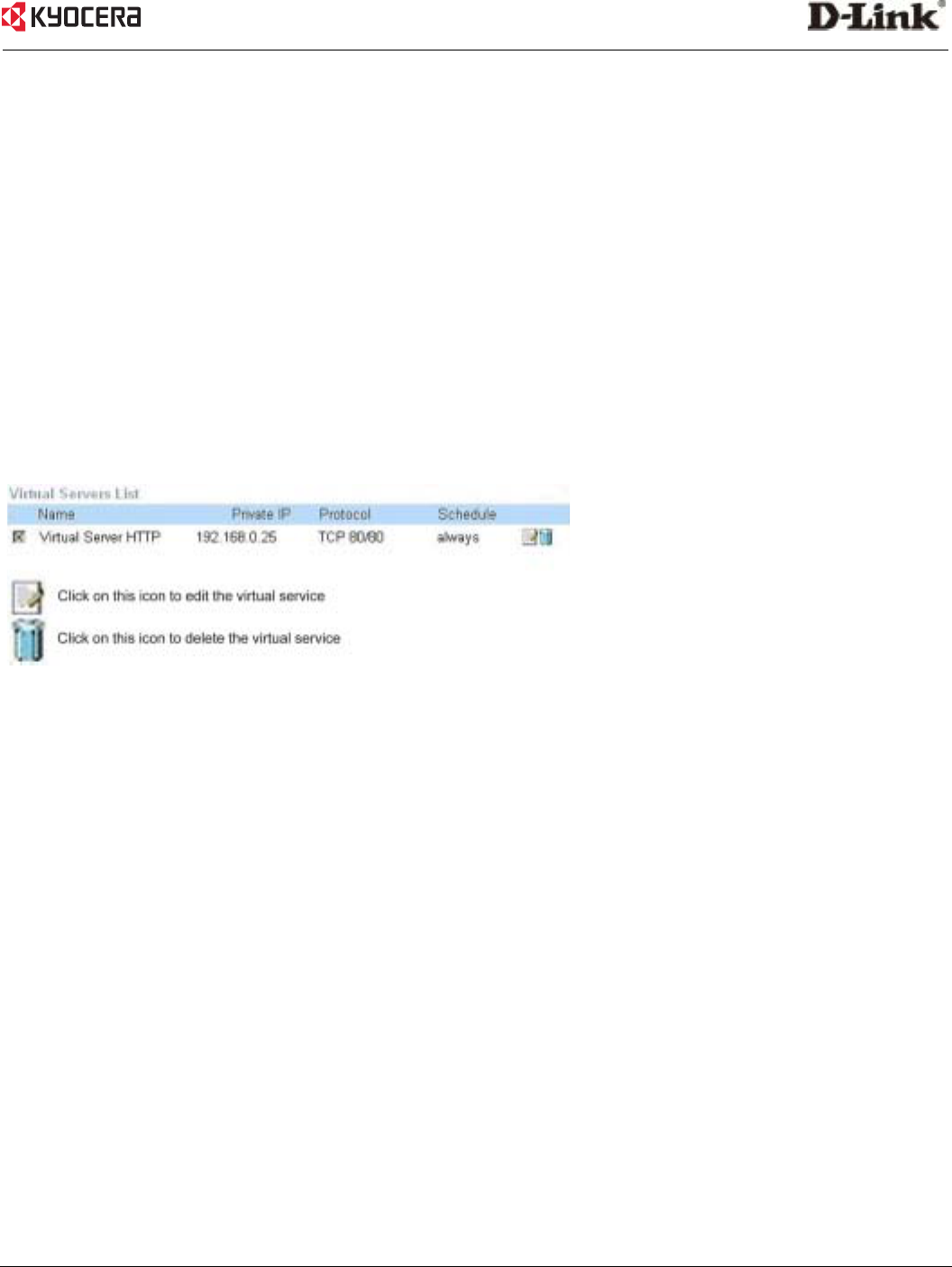
Using the Configuration Menu 17
Private Port- The port number of the service used by the Private IP computer.
Public Port- The port number on the WAN (Wide Area Network) side that is used to access the virtual service.
Schedule- The schedule of time when the virtual service gets enabled. The schedule may be set to Always, which
allows the particular service to always be enabled. If it is set to Time, select the time frame for the service to be
enabled. If the system time is outside of the scheduled time, the service is disabled.
Example #1: If you have a Web server that you wanted Internet users to access at all times, you would need to enable it.
Web (HTTP) server is on LAN (Local Area Network) computer
192.168.0.25. HTTP uses port 80, TCP.
Name: Web Server
Private IP: 192.168.0.25
Protocol Type: TCP
Private Port: 80
Public Port: 80
Schedule: always
Example #2: If you have an FTP server that you wanted Internet users to access by WAN port 2100 and only during the
weekends, you would need to enable it as such. FTP server is on LAN computer 192.168.0.30. FTP uses port 21, TCP.
Name: FTP Server
Private IP: 192.168.0.30
Protocol Type: TCP
Private Port: 21
Public Port: 2100
Schedule: From: 01:00AM to 01:00AM, Sat to Sun
All Internet users who want to access this FTP Server must connect to it from port 2100. This is an example of port
redirection and can be useful in cases where there are many of the same servers on the LAN network.
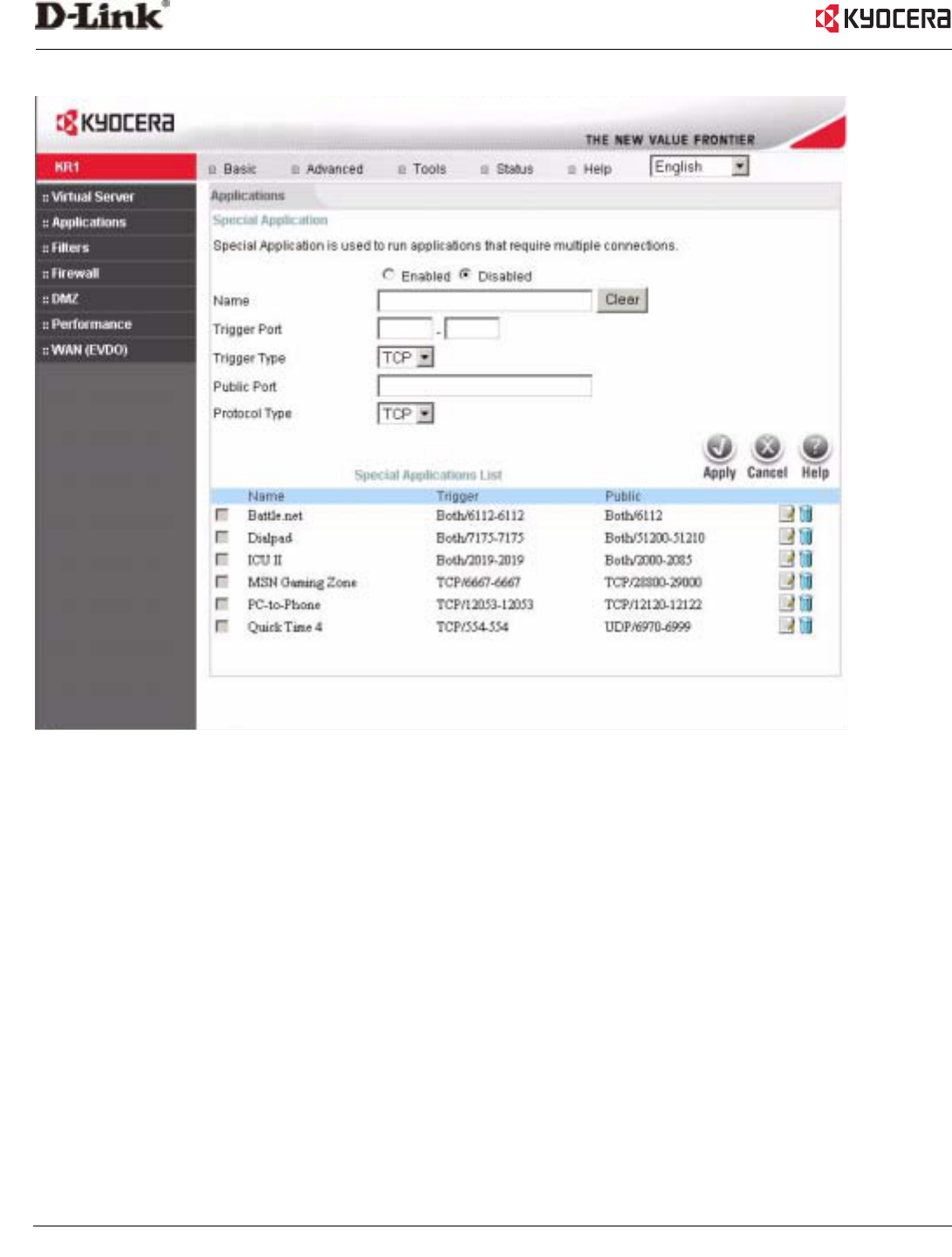
18 Kyocera KR1 Mobile Router User Guide
Advanced > Applications
Some applications require multiple connections, such as Internet gaming, video conferencing, Internet telephony
and others. These applications have difficulties working through NAT (Network Address Translation). Special
Applications makes some of these applications work with the Kyocera KR1 Mobile Router. If you need to run
applications that require multiple connections, specify the port normally associated with an application in the
"Trigger Port" field, select the protocol type as TCP or UDP, then enter the public ports associated with the trigger
port to open them for inbound traffic.
The Kyocera KR1 Mobile Router provides some predefined applications in the table on the bottom of the web page.
Select the application you want to use and enable it.
Note: Only one PC can use each Special Application tunnel.
Name- This is the name referencing the special application.
Trigger Port- This is the port used to trigger the application. It can be either a single port or a range of ports.
Trigger Type- This is the protocol used to trigger the special application. By default the Trigger Type is TCP.
Public Port- This is the port number on the WAN side that is used to access the application. You may define a single
port or a range of ports. You can use a comma to add multiple ports or port ranges.
Protocol Type- This is the protocol used for the special application.By default the Trigger Type is TCP.
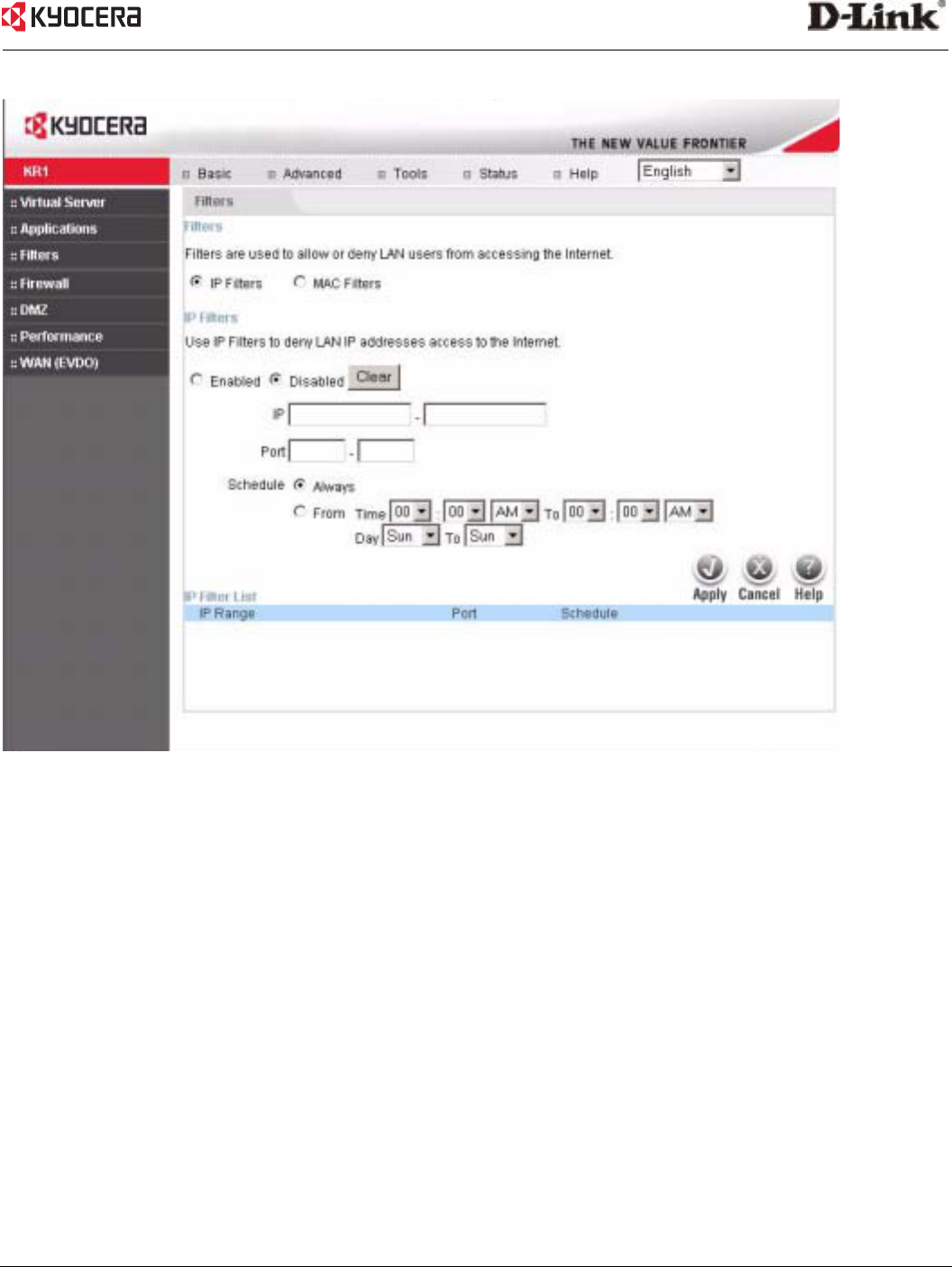
Using the Configuration Menu 19
Advanced > Filters > IP Filters
Filters- Filters are used to deny or allow LAN (Local Area Network) computers from accessing the Internet. The
Kyocera KR1 Mobile Router can be setup to deny internal computers by their IP or MAC addresses. The Kyocera
KR1 Mobile Router can also block users from accessing restricted web sites.By default the Filters is IP Filters.
IP Filters- Use IP Filters to deny LAN IP addresses from accessing the Internet. You can deny specific port numbers
or all ports for the specific IP address.By default the IP Filters is Disabled.
IP- The IP address of the LAN computer that is denied access to the Internet.
Port- The single port or port range that is denied access to the Internet.
Schedule- This is the schedule of time when the IP Filter gets enabled. By default the Schedule is Always.
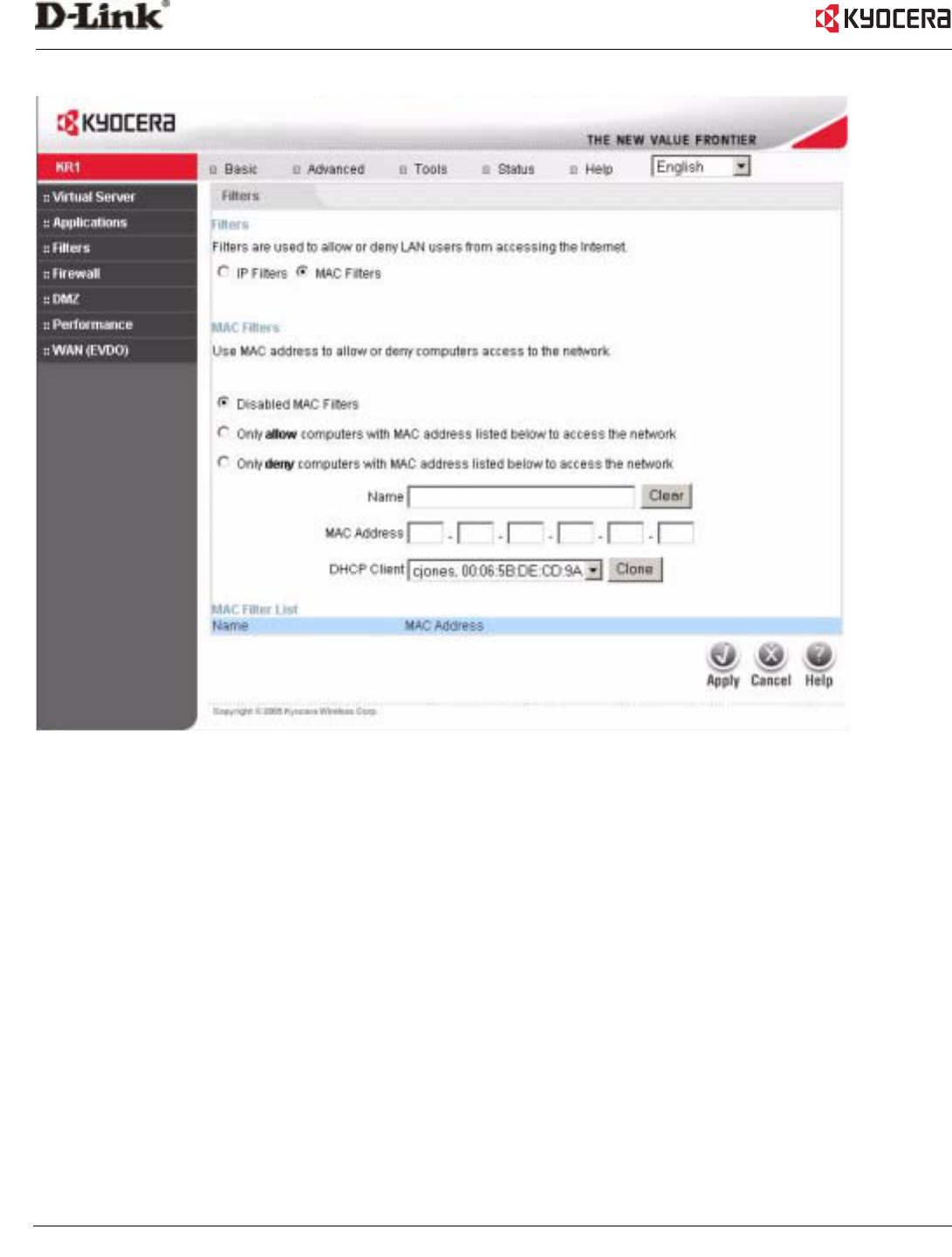
20 Kyocera KR1 Mobile Router User Guide
Advanced > Filters > MAC Filters
Use MAC (Media Access Control) Filters to allow or deny LAN (Local Area Network) computers by their MAC
addresses from accessing the Network. You can either manually add a MAC address or select the MAC address from
the list of clients that are currently connected to the Broadband Router.
Filters- Select the filter you wish to use; in this case, MAC filters was chosen.
MAC Filters- Choose Disable MAC filters; allow MAC addresses listed below; or deny MAC addresses listed below.
By default the MAC Filters is Disabled MAC Filters.
Name- Enter the name here.
MAC Address- Enter the MAC Address.
DHCP Client- Select a DHCP client from the pull-down list; click Clone to copy that MAC Address.
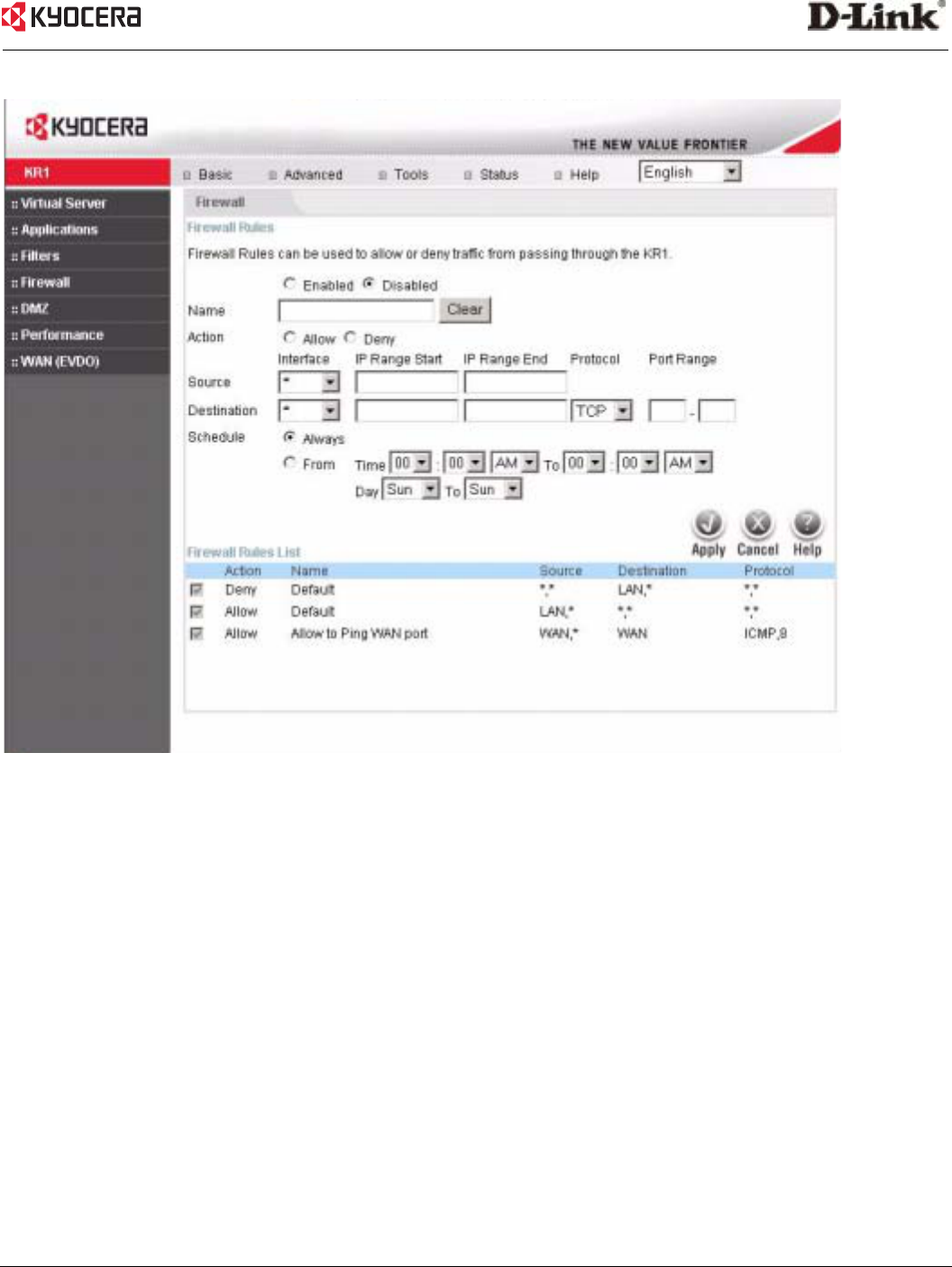
Using the Configuration Menu 21
Advanced > Firewall
Firewall Rules is an advanced feature used to deny or allow traffic from passing through the Kyocera KR1 Mobile
Router. It works in the same way as IP Filters with additional settings. You can create more detailed access rules for
the Kyocera KR1 Mobile Router. When virtual services are created and enabled, it also displays in Firewall Rules.
Firewall Rules contain all network firewall rules pertaining to IP (Internet Protocol).
In the Firewall Rules List at the bottom of the screen, the priorities of the rules are from top (highest priority)
to bottom (lowest priority.)
Note: The Kyocera KR1 Mobile Router MAC Address filtering rules have precedence over the Firewall Rules.
Firewall Rules- Enable or disable the Firewall. By default the Firewall Rules is Disabled.
Name- Enter the name
Action- Allow or Deny
Source- Enter the IP Address range
Destination- Enter the IP Address range; the Protocol; and the Port Range. By default the Protocol is TCP.
Schedule- Select Always or enter the Time Range. By default the Schedule is Always.
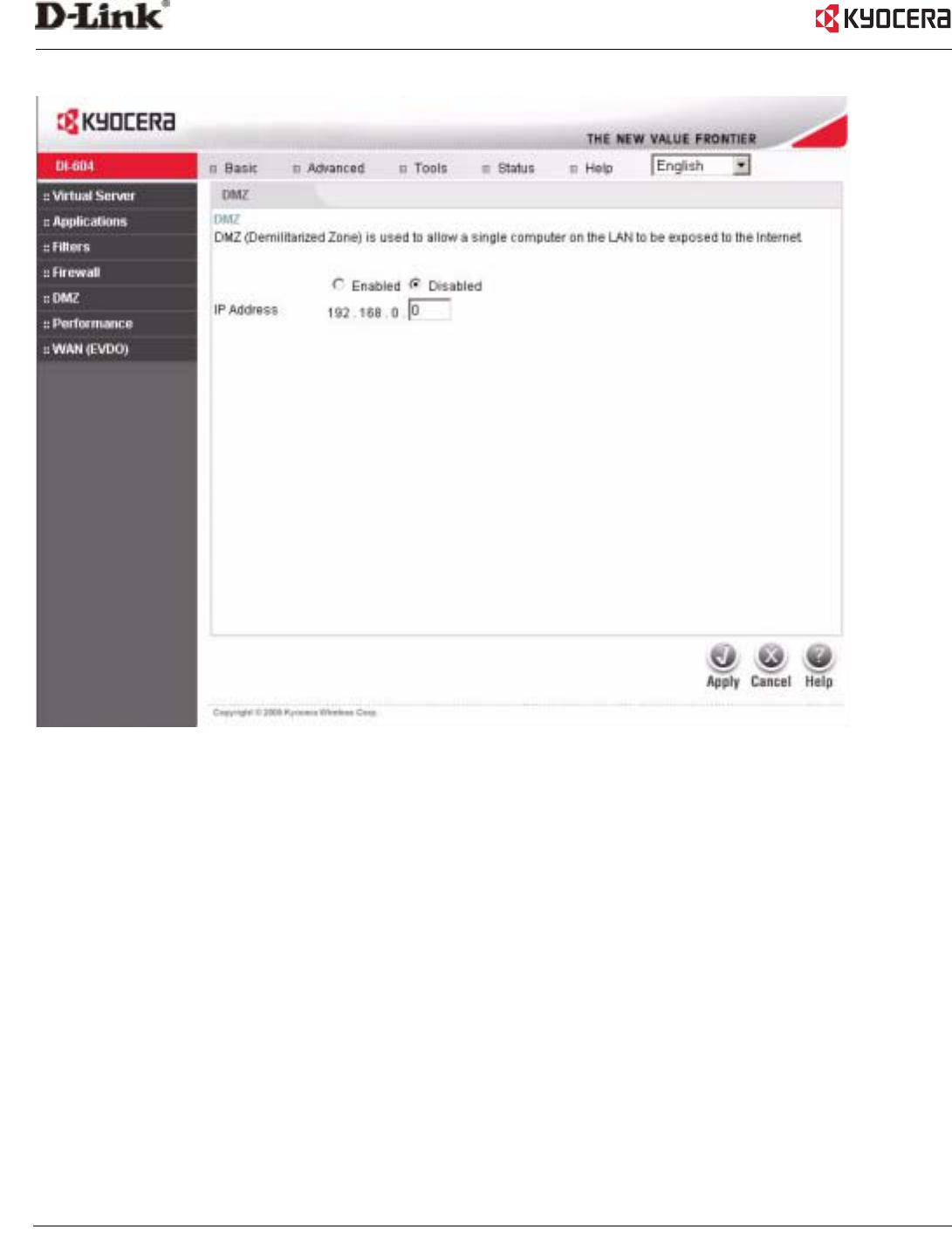
22 Kyocera KR1 Mobile Router User Guide
Advanced > DMZ
If you have a client PC that cannot run Internet applications properly from behind the Kyocera KR1 Mobile Router,
then you can set the client up for unrestricted Internet access. It allows a computer to be exposed to the Internet.
This feature is useful for gaming purposes. Enter the IP address of the internal computer that will be the DMZ host.
Adding a client to the DMZ (Demilitarized Zone) may expose your local network to a variety of security risks, so
only use this option as a last resort.
DMZ- Enable or Disable the DMZ. The DMZ (Demilitarized Zone) allows a single computer to be exposed to the
Internet. By default the DMZ is Disabled.
IP Address -Enter the IP Address of the computer to be in the DMZ.
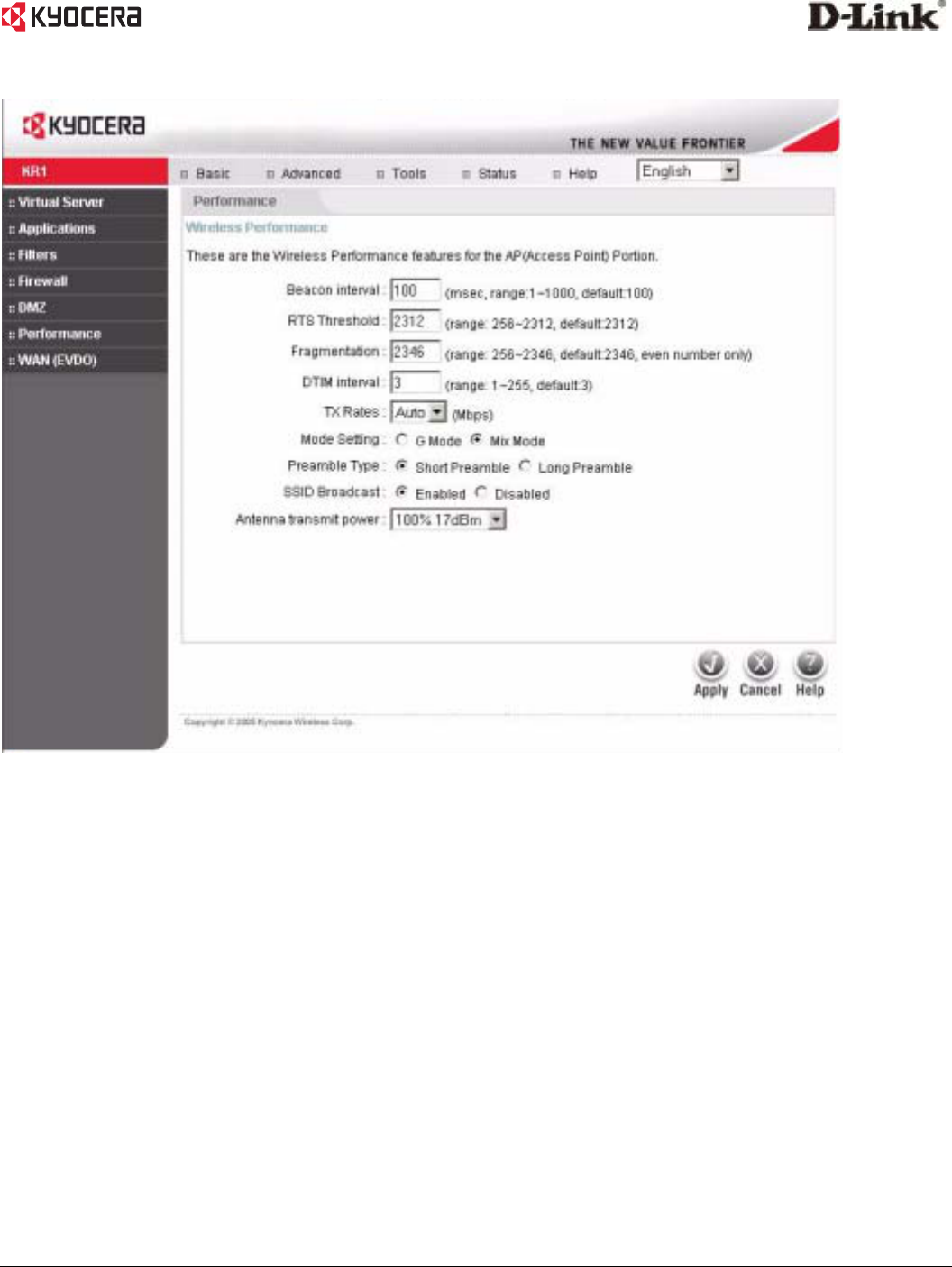
Using the Configuration Menu 23
Advanced > Performance
Wireless Performance- Displayed in this window are the Wireless Performance features for the Access Point portion
of the Kyocera KR1 Mobile Router.
Beacon Interval- Beacons are packets sent by an Access Point to synchronize a wireless network. Specify a value.
By default the Beacon Interval is 100. This is the recommended setting.
RTS Threshold- This value should remain at its default setting of 2312. If inconsistent data flow is a problem, only a
minor modification should be made.
Fragmentation- The fragmentation threshold, which is specified in bytes, deter-mines whether packets get
fragmented. Packets exceeding the 2346 byte setting are fragmented before transmission. By default the
Fragmentation is 2346.
DTIM interval- (Delivery Traffic Indication Message). A DTIM is a countdown informing clients of the next window
for listening to broadcast and multicast messages. By default the DTIM interval is 3.
TX Rates-Auto- is the default selection. Select from the drop down menu.
Mode Setting- Select G Mode is your wireless network consists of only 802.11g clients. If your wireless network
includes 802.11b clients, select Mix Mode.

24 Kyocera KR1 Mobile Router User Guide
Preamble Type- Select Short or Long Preamble. The Preamble defines the length of the CRC block (Cyclic
Redundancy Check is a common technique for detecting data transmission errors) for communication between the
Kyocera KR1 Mobile Router and the roaming wireless network adapters. Note: High network traffic areas should use
the shorter preamble type. By default the Preamble Type is Short Preamble.
SSID Broadcast- Choose Enabled to broadcast the SSID across the network. All devices on a network must share the
same SSID (Service Set Identifier) to establish communication. Choose Disabled if you do not wish to broadcast the
SSID over the network. By default the SSID Broadcast is Disabled.
Antenna transmit power- Antenna transmit power is the level at which your Wireless Access Point (WAP) transmits the
wireless signal. You may select from the following four options: 100% 17dBm, 50% 15dBm, 25% 12 dBm, and
12.5% 10dBm. 100% 17dBm is the default. Select this option if you desire a larger wireless coverage area. Select 12.5%
10dBm for a smaller wireless coverage area.

Using the Configuration Menu 25
Advanced > WAN (EVDO)
Caution for WAN (EVDO) Networking: The WAN (EVDO) fields will be populated by your EVDO card.
Ensure that you do not alter these settings or EVDO service could be disrupted.
Please refer to your EVDO documentation, or service provider information for additional information.
User Name- Please do not alter this setting.
Password- Please do not alter this setting.
Retype Password- Please do not alter this setting.
Server-name- Please do not alter this setting.
Dial Number- The default is #777. Please do not alter this setting.

26 Kyocera KR1 Mobile Router User Guide
Tools > Admin
The Tools > Admin menu allows an administrator to change the system password.
Two account options are available: admin and user.
The Admin account option allows read/write access.
The User account option allows for read-only access only. Within this option, the user can view settings, but cannot
make any changes.
Administrator- admin is the Administrator login name
Password- Enter the password. and then re-enter the password for confirmation.
User- user is the User login name
Password- Enter the password, and then re-enter the password for confirmation.
Remote Management- Remote management allows the Kyocera KR1 Mobile Router to be configured from the
Internet by a web browser. A username and password is still required to access the Web-Management
interface. In general, only a member of your network can browse the built-in web pages to perform
Administrator tasks. This feature enables you to perform Administrator tasks from the remote (Internet) host.
IP Address- The Internet IP address of the computer that has access to the Broadband Router. If you input an asterisk
(*) into this field, then any computer is able to access the Router. Putting an asterisk (*) into this field would present
a security risk and is not recommended.
Subnet Mask- All the devices in the network must share the same subnet mask.
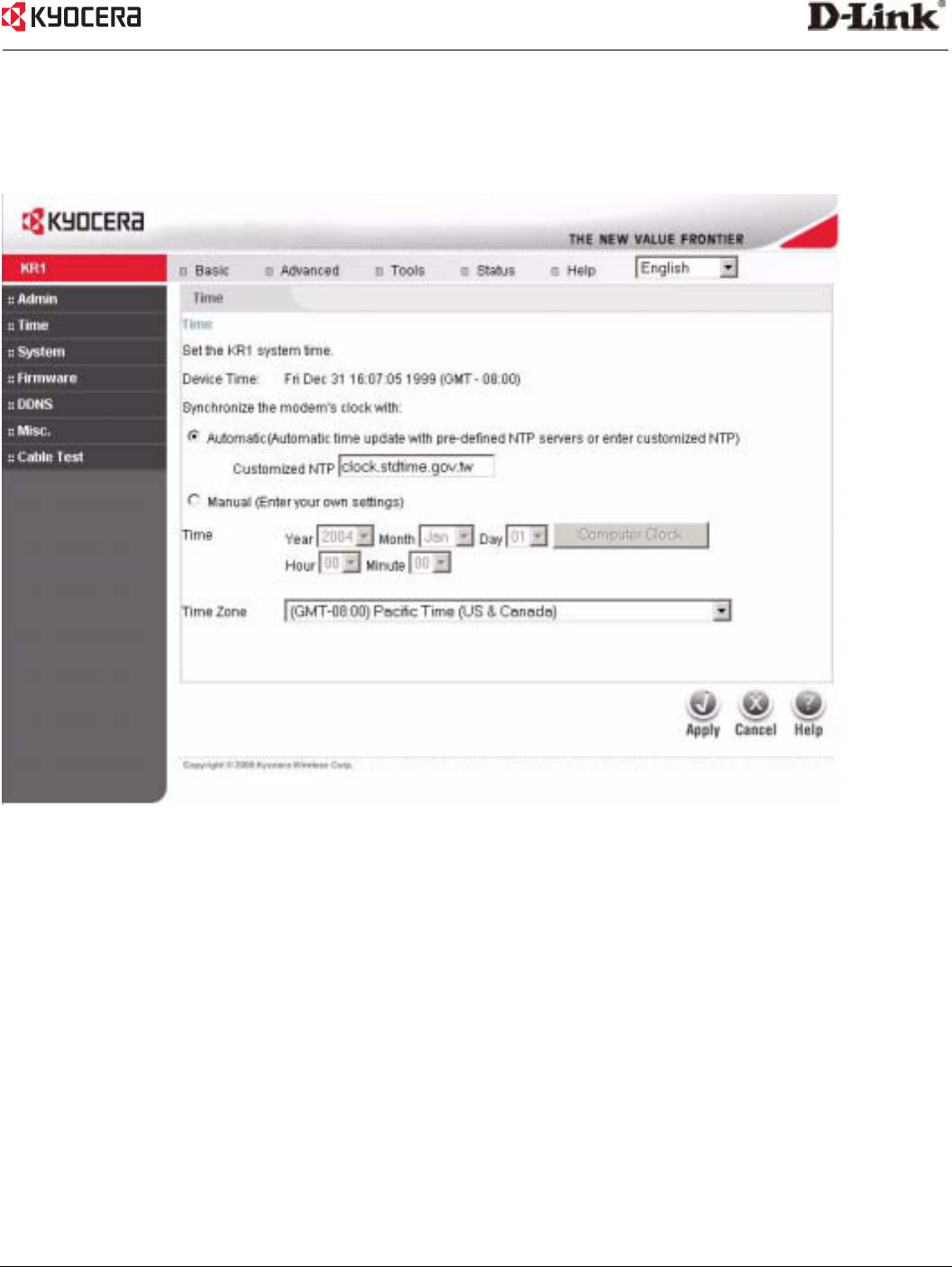
Using the Configuration Menu 27
Port- The port number used to access the Broadband Router.
Example- http://x.x.x.x:8080 where x.x.x.x is the WAN IP address of the Broadband Router and 8080 is the port
used for the Web-Management interface.
Tools > Time
Synchronize the modem’s clock with- NTP is short for Network Time Protocol. NTP synchronizes computer clock
times in a network of computers. You have the option to manually set the time or have it automatically done for you.
By default the Synchronize the modem’s clock with is Automatic.
Time- To manually input the time, enter the values in these fields for the Year, Month, Day, Hour, and Minute.
Click Set Time.
Time Zone- Select the Time Zone from the pull-down menu.
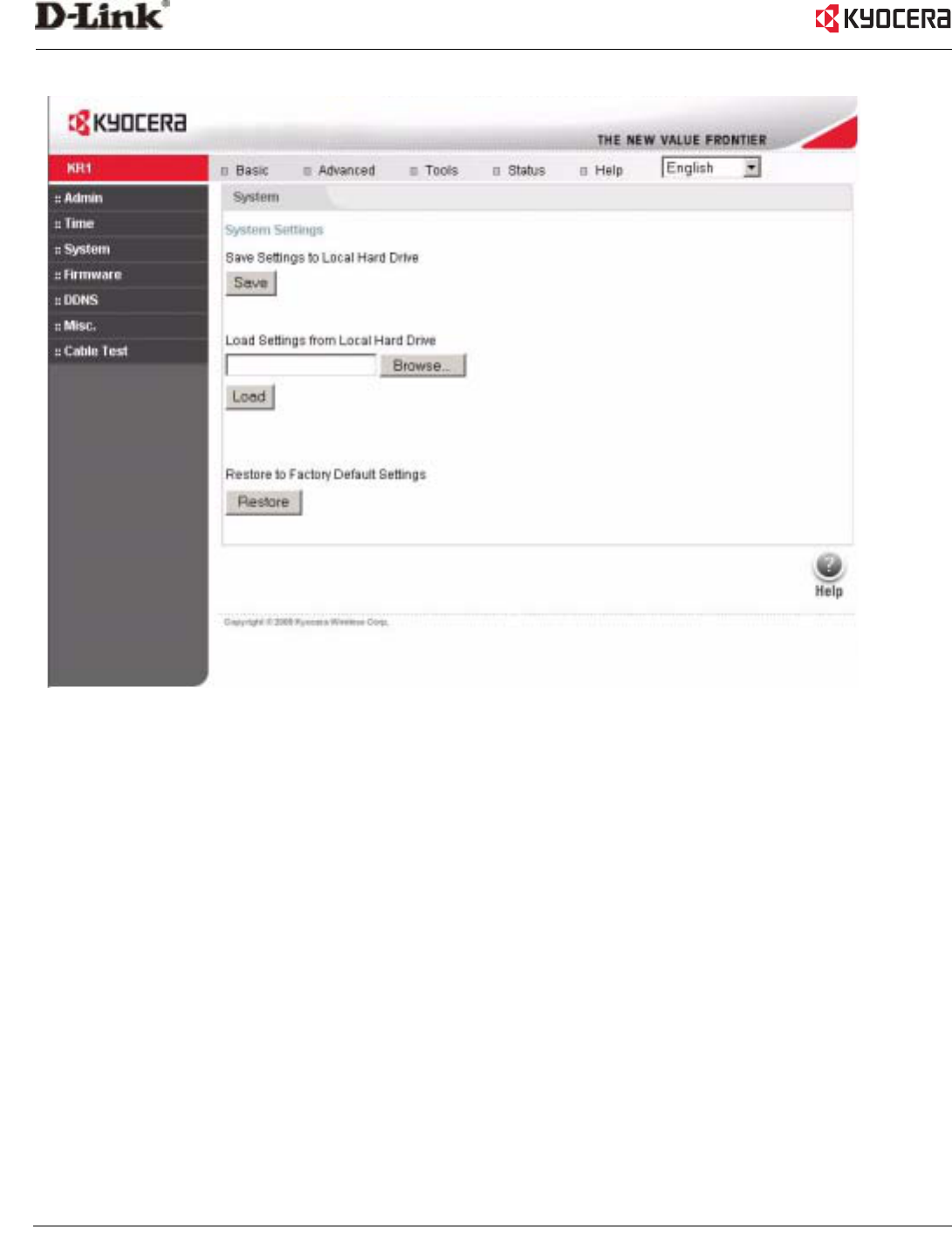
28 Kyocera KR1 Mobile Router User Guide
Tools > System
The current system settings can be saved as a file onto the local hard drive. The saved file, or any other saved
settings file, can be loaded back on the Broadband Router. To reload a system settings file, click on Browse to browse
the local hard drive and locate the system file to be used. You may also reset the Broadband Router back to factory
settings by clicking Restore.
Save Settings to Local Hard Drive- Click Save to save the current settings to the local Hard Drive
Load Settings from Local Hard Drive- Click Browse to find the settings, then click Load
Restore to Factory Default Settings- Click Restore to restore the factory default settings
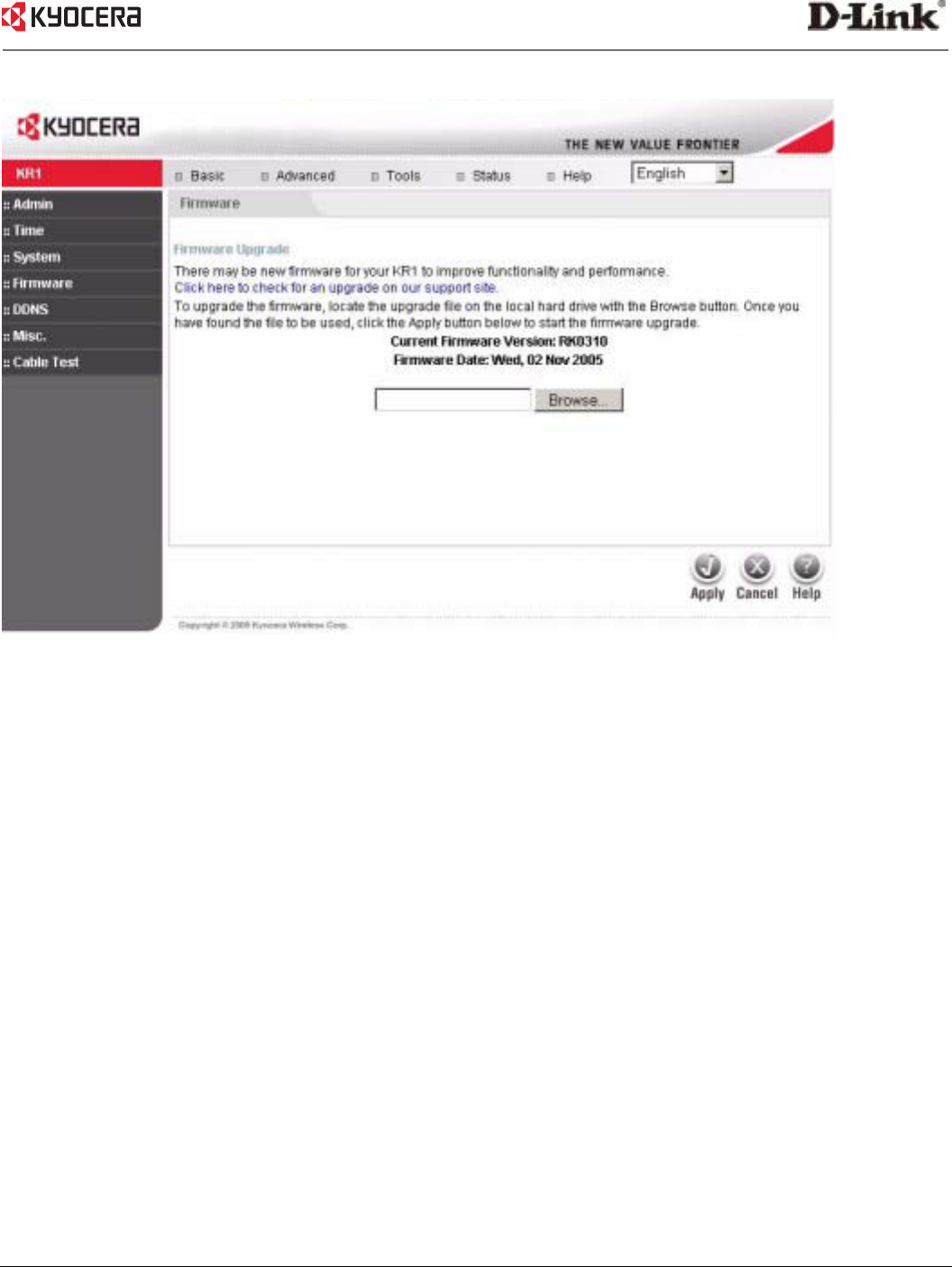
Using the Configuration Menu 29
Tools > Firmware
You can upgrade the firmware of the Kyocera KR1 Mobile Router from this menu.
Ensure the firmware you want to use is on the local hard drive of your computer.
Click on Browse to browse and locate the firmware to be used for your update.
Please check the Kyocera support site at http://www.kyocera-wireless.com for firmware updates and
related information.
Caution: Due to packet loss, please do not use a WiFi connection for firmware upgrades.
Firmware Upgrade- Click on the link in this screen to find out if there is an updated firmware version. If so, download
the new firmware to your hard drive.
Browse- After you have downloaded the new firmware, click Browse in this window to locate the firmware update
on your hard drive. Click Apply to complete the firmware upgrade.
Note: The firmware upgrade process will take three to five minutes.
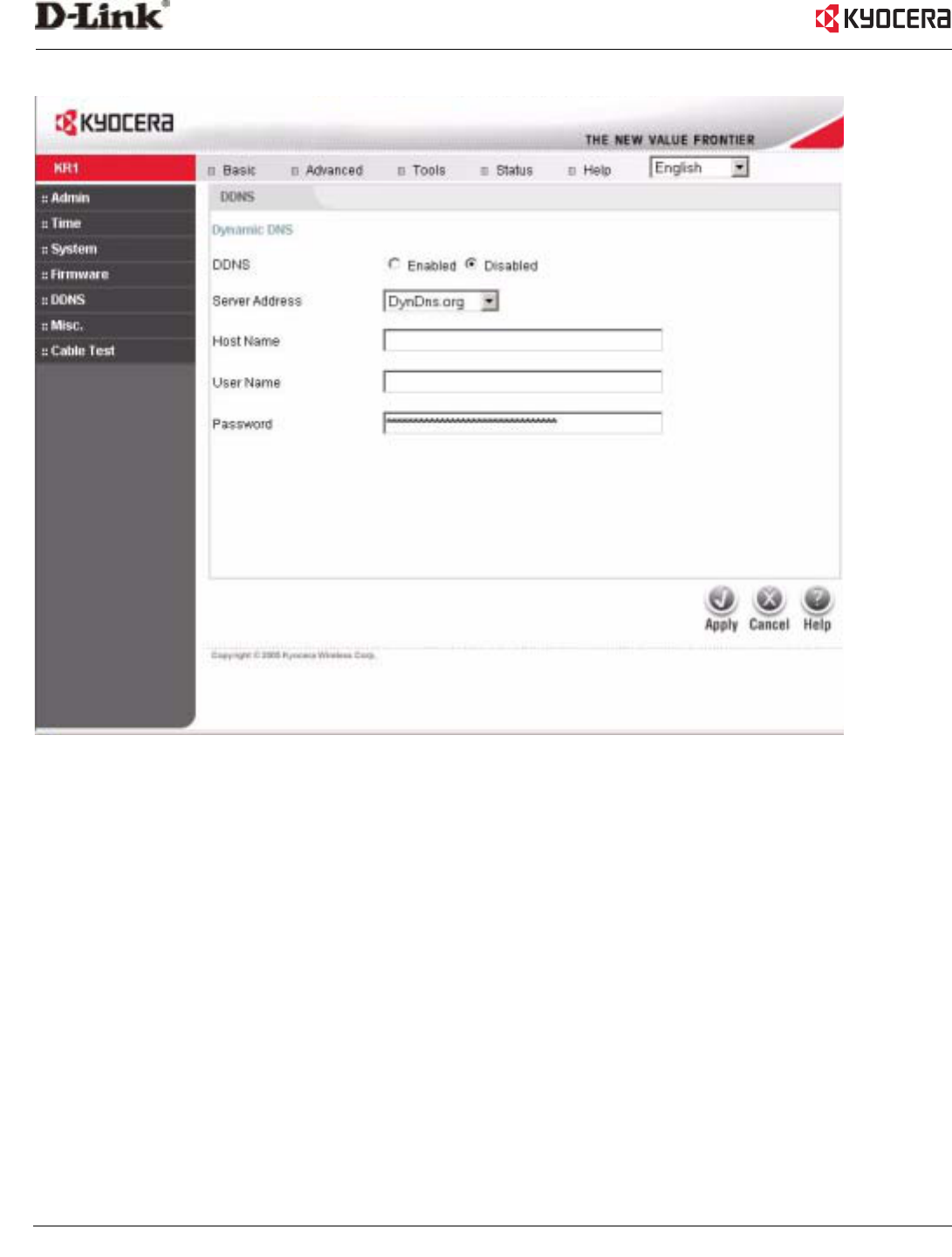
30 Kyocera KR1 Mobile Router User Guide
Tools > DDNS
DDNS- To use the Dynamic Domain Name Server update the client built into the router, click Enabled.
By default the DDNS is Disabled.
Server Address- Choose your DDNS provider from the drop down menu.
Host Name- Enter the Host Name that you registered with your DDNS service provider.
User Name- Enter the User Name for your DDNS account.
Password- Enter the Password for your DDNS account.
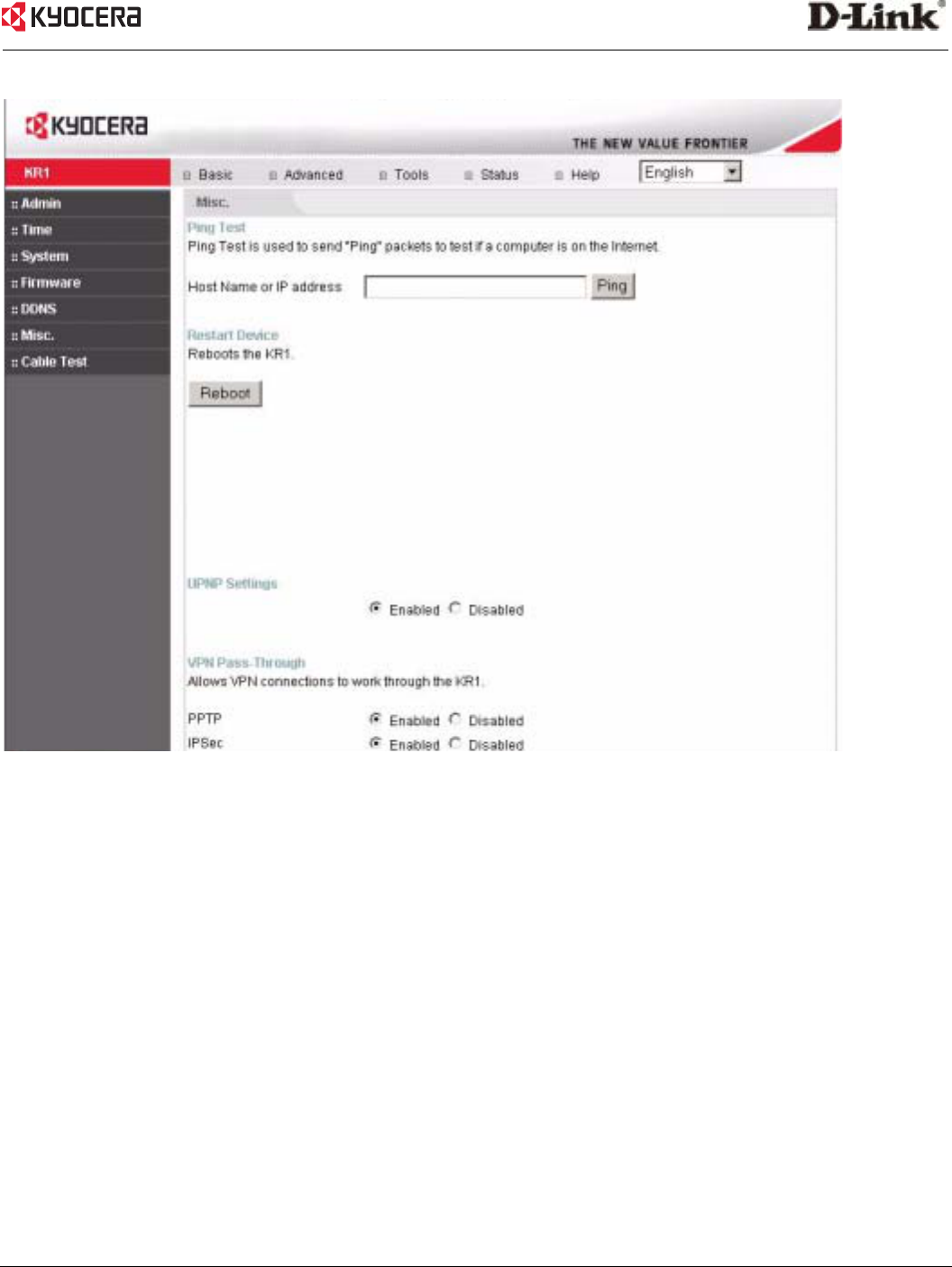
Using the Configuration Menu 31
Tools > Misc
Ping Test- The Ping Test is used to send Ping packets to test if a computer is on the Internet. Enter the IP Address that
you wish to Ping, and click Ping.
Restart Device- Click Reboot to restart the Kyocera KR1 Mobile Router. This will take a few minutes.
Block WAN Ping- Discard Ping from WAN If you choose to block WAN Ping, the WAN IP address of the Kyocera KR1
Mobile Router does not respond to pings. Blocking the Ping may provide some extra security from hackers. Discard
Ping from WAN side. Click Enabled to block the WAN ping. By default the Block WAN Ping is Enabled.
UPNP- To use the Universal Plug and Play feature click on Enabled. UPNP provides compatibility with networking
equipment, software and peripherals of the over 400 vendors that cooperate in the Plug and Play forum. By default
the UPNP Ping is Enabled.
VPN Pass Through- The Kyocera KR1 Mobile Router supports VPN (Virtual Private Network) pass-through for both
PPTP (Point-to-Point Tunneling Protocol) and IPSec (IP Security). Once VPN pass-through is enabled, there is no
need to open up virtual services. Multiple VPN connections can be made through the Kyocera KR1 Mobile Router.
This is useful when you have many VPN clients on the LAN network.
PPTP- select Enabled or Disabled. By default the PPTP is Enabled.
IPSec- select Enabled or Disabled.By default the IPSec is Enabled.
Multicast Streams- Enter this option to allow Multicast traffic to pass through the Kyocera KR1 Mobile Router
from the Internet.
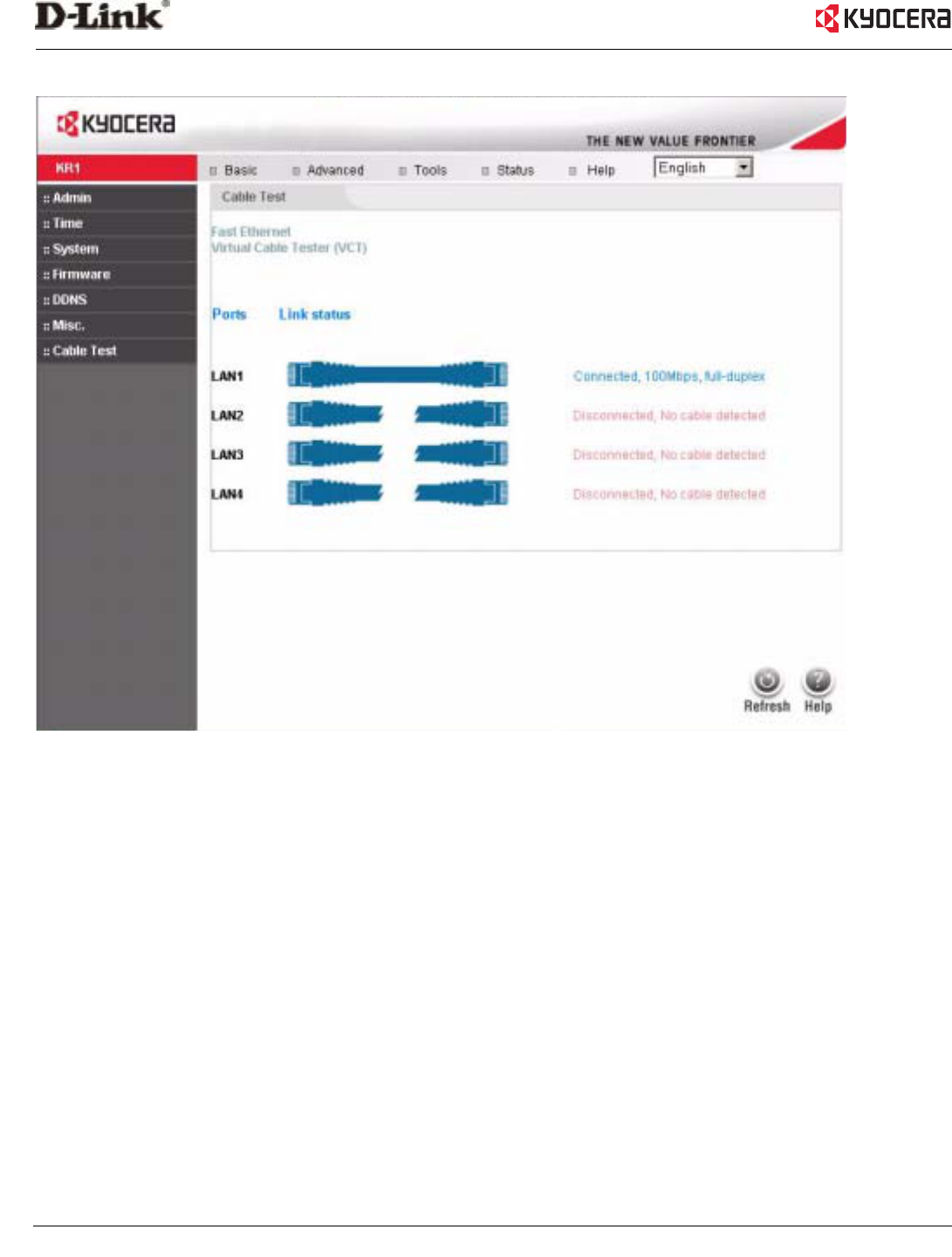
32 Kyocera KR1 Mobile Router User Guide
Tools > Cable Test
This page displays the current information for the Kyocera KR1 Mobile Router, which will assist you in
troubleshooting your network. It will display which port on the Kyocera KR1 Mobile Router is currently connected.
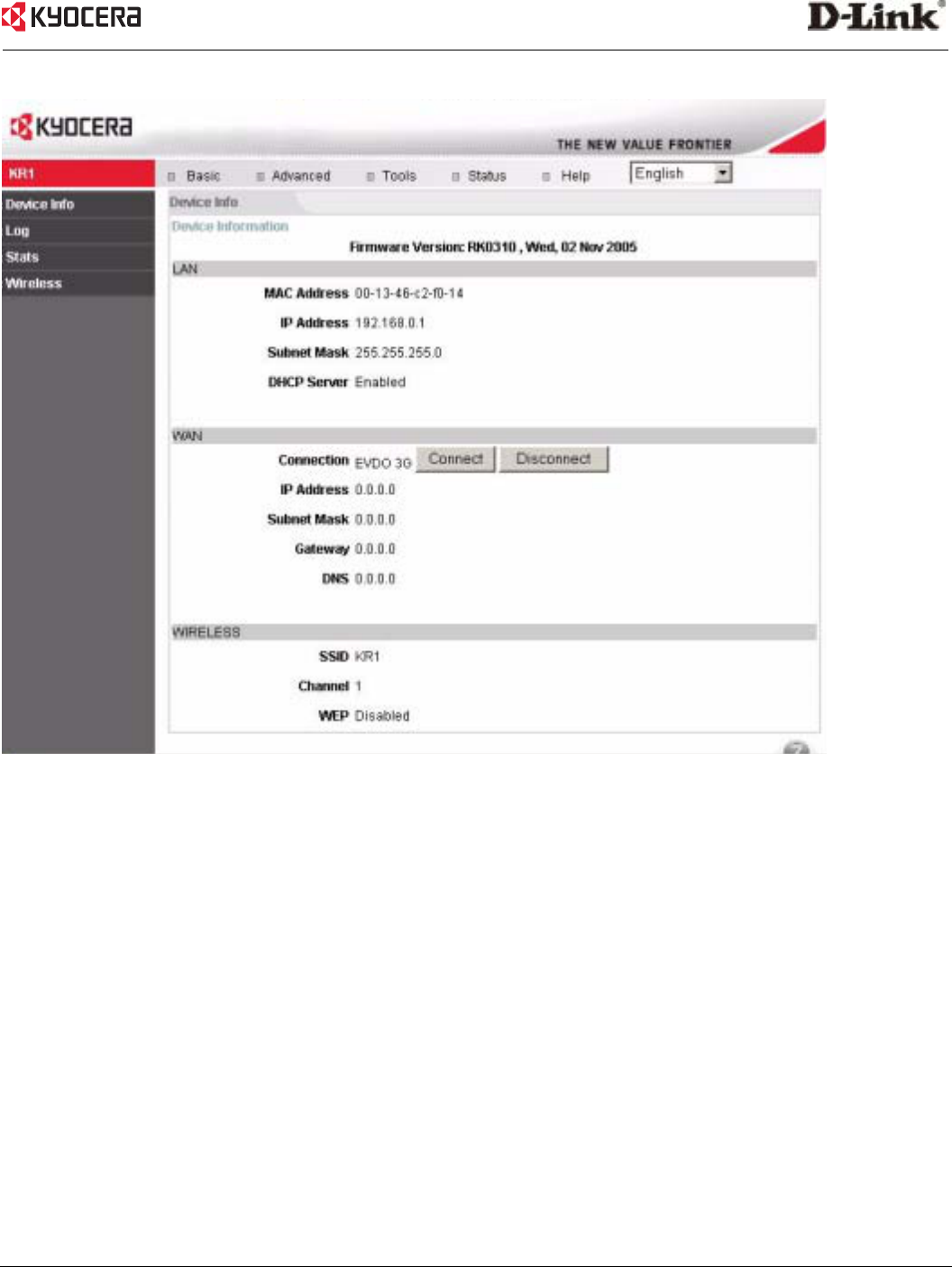
Using the Configuration Menu 33
Status > Device Info
This page displays the current LAN, WWAN, and WIRELESS information for the Kyocera KR1 Mobile Router. A
connection to the EVDO network will be established when the unit is powered on. Use the Disconnect button to
disconnect from the EVDO network; use the Connect button to establish a connection.
LAN Address: Displays the MAC address
IP Address: LAN/Private IP Address of the KR1.
Subnet Mask: LAN/Private Subnet Mask of the KR1.
DHCP Server: Shows whether or not the DHCP server is Enabled or Disabled
WWAN Connection: Displays which device is connected to the Kyocera KR1 Mobile Router
IP Address: WAN/Public IP Address
Subnet Mask:Subnet Mask: WAN/Public Subnet Mask
Gateway: WAN/Public Gateway IP Address
Domain Name Server: WAN/Public DNS IP Address
WIRELESS SSID: Displays the current SSID. By default the SSID is KR1.
SSI Channel: Displays the current channel. By default the Channel is 2.
WEP: Indicates whether WEP is enabled or disabled. By default the WEP is Disabled.
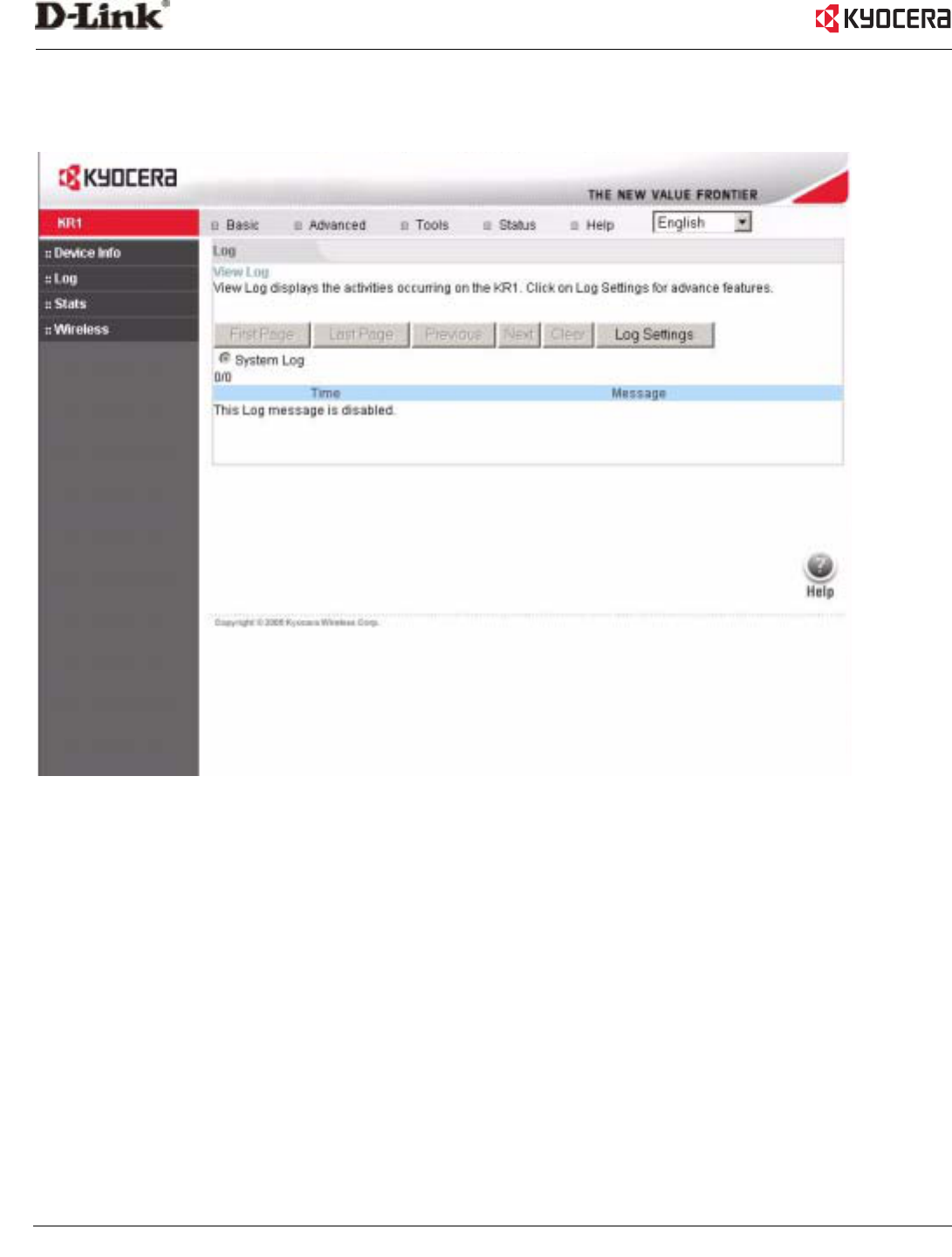
34 Kyocera KR1 Mobile Router User Guide
Status > Log
The Kyocera KR1 Mobile Router keeps a running log of events and activities.
Select the Log Settings button.The following screen appears.
View Log-
First Page- The first page of the log
Last Page- The last page of the log
Previous- Moves back one log page
Next- Moves forward one log page
Clear- Clears the logs completely
Log Settings- Brings up the page to configure the log
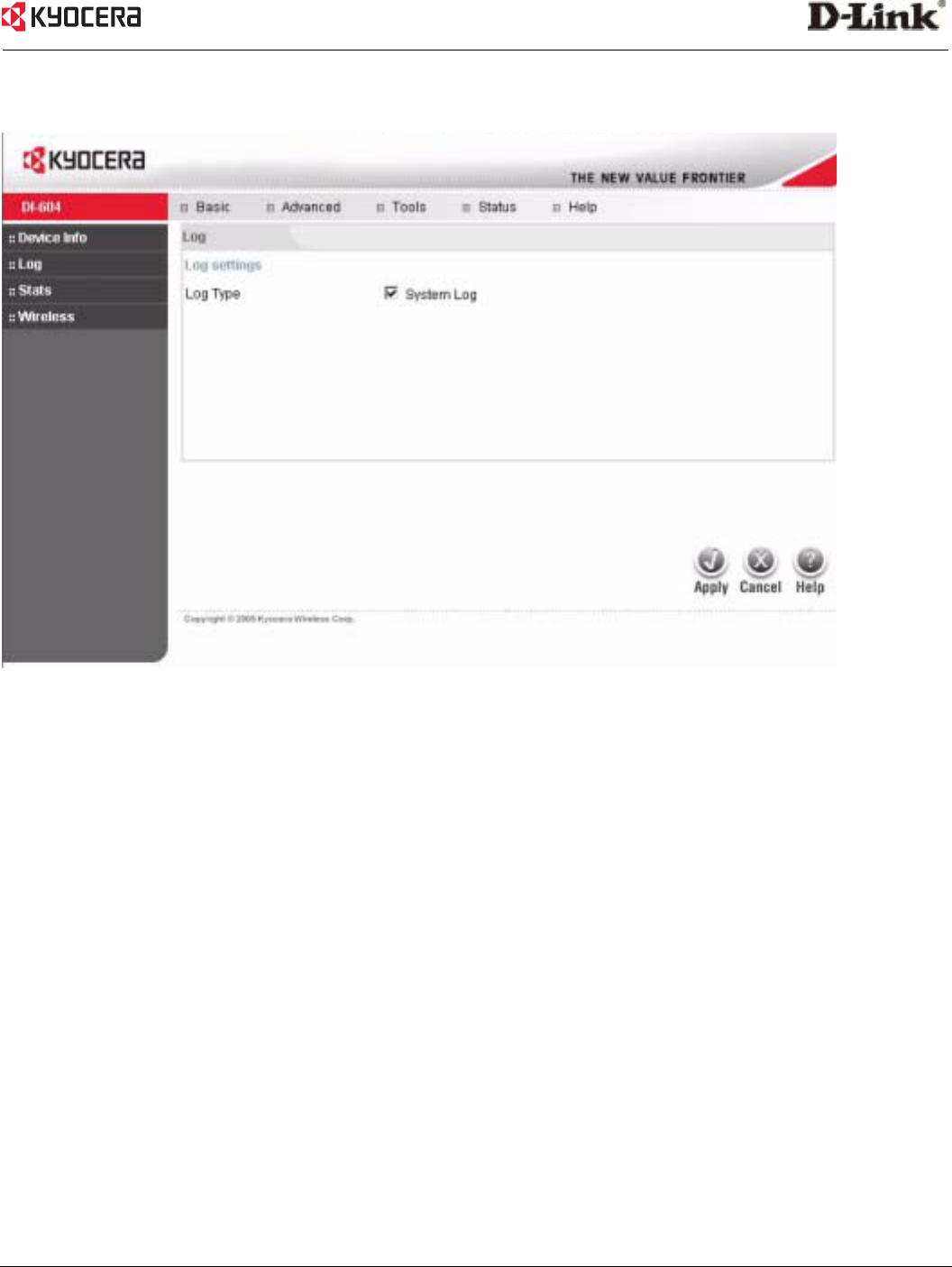
Using the Configuration Menu 35
Status > Log > Log Settings #2
Check the box next to System Log. Click Apply.
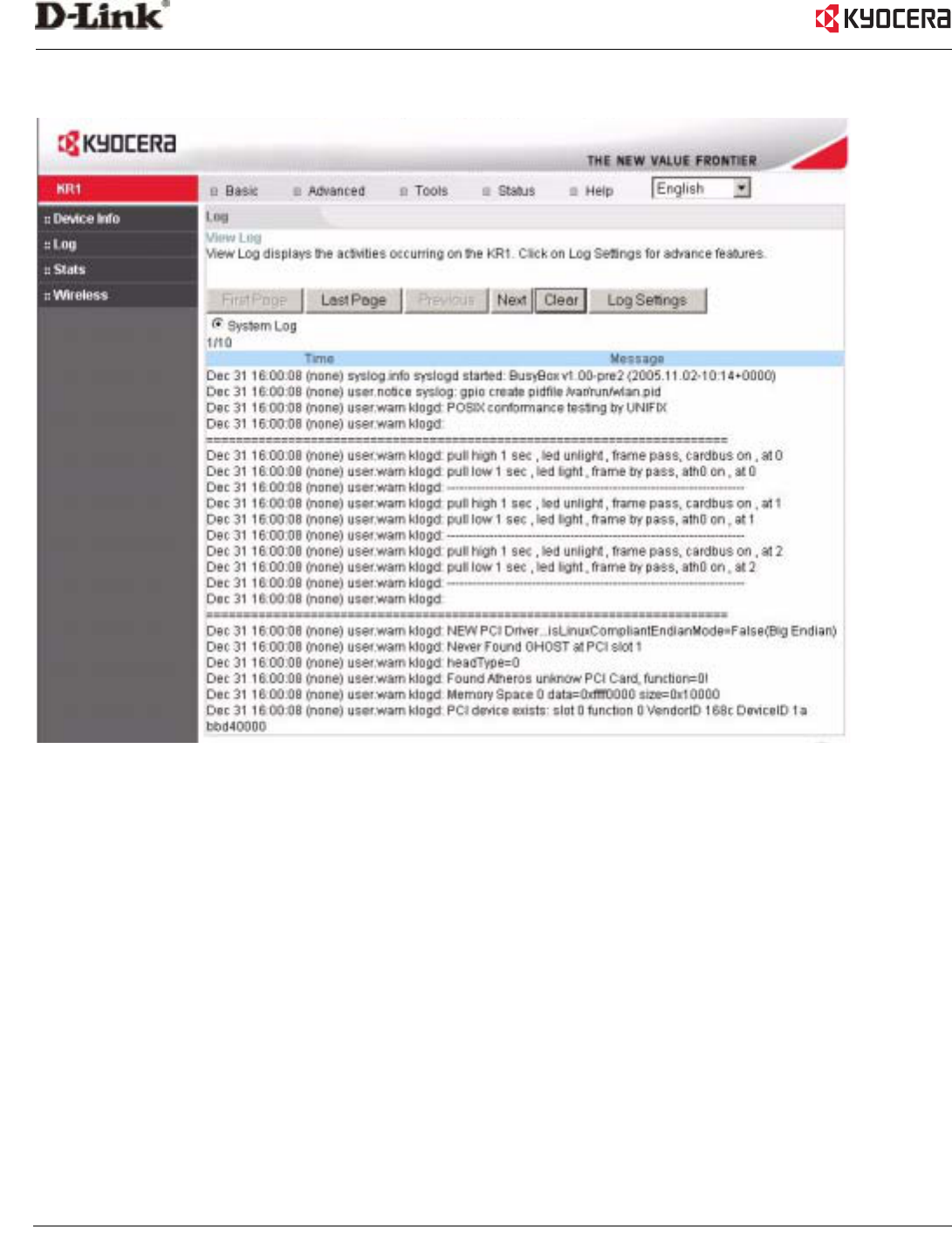
36 Kyocera KR1 Mobile Router User Guide
Status > Log > Log Settings #3
A screen will display the Kyocera KR1 Mobile Router log settings.
Note: If the device is rebooted, the logs are automatically cleared.
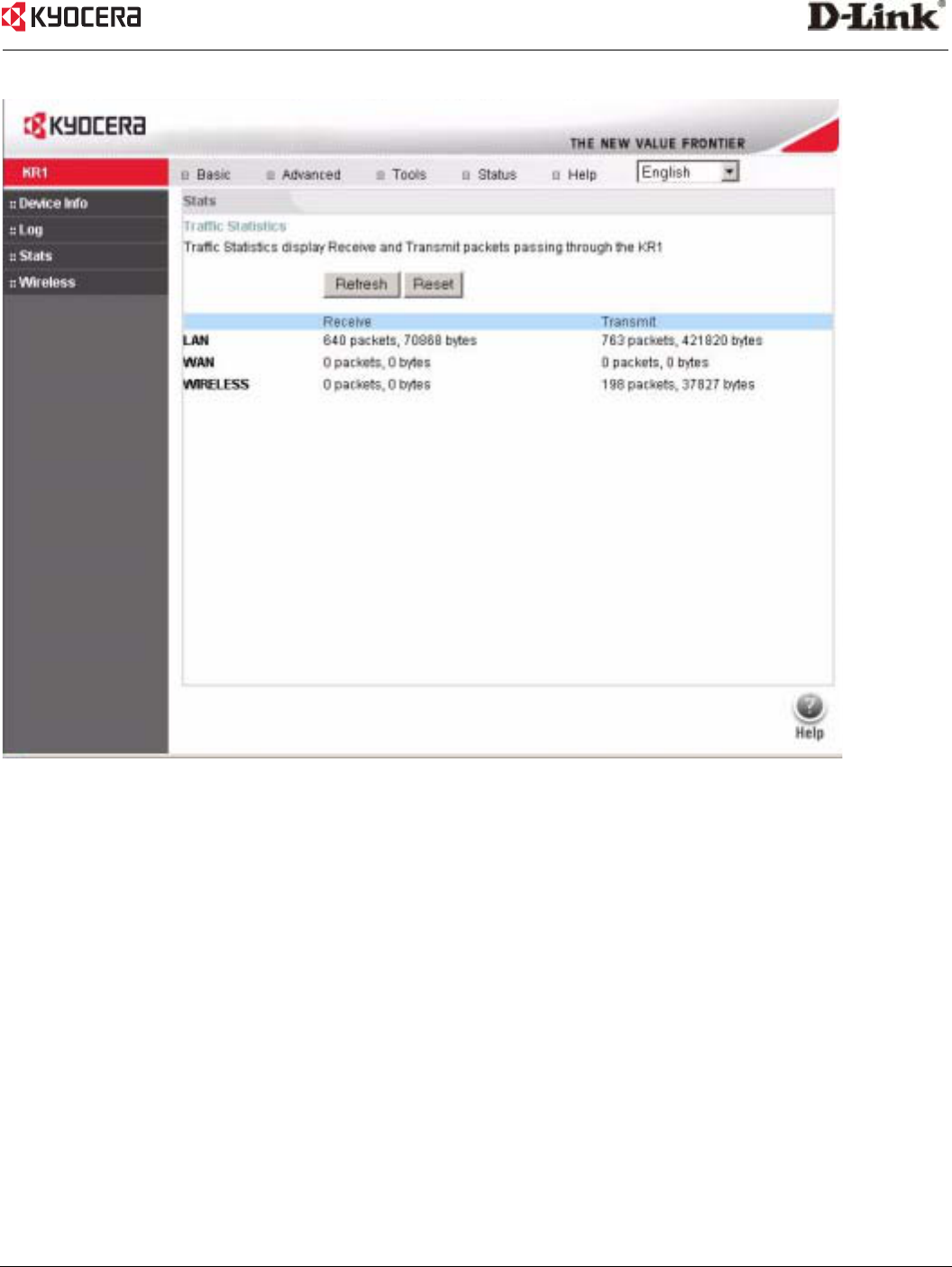
Using the Configuration Menu 37
Status > Stats
The screen above displays the Traffic Statistics. Here you can view the amount of packets that pass through the
Kyocera KR1 Mobile Router on both the WAN and the LAN Ports. The traffic counter resets if the device is rebooted.
The wireless client table displays a current list of connected wireless clients. This table also displays the connection
time and MAC address of the connected wireless client.
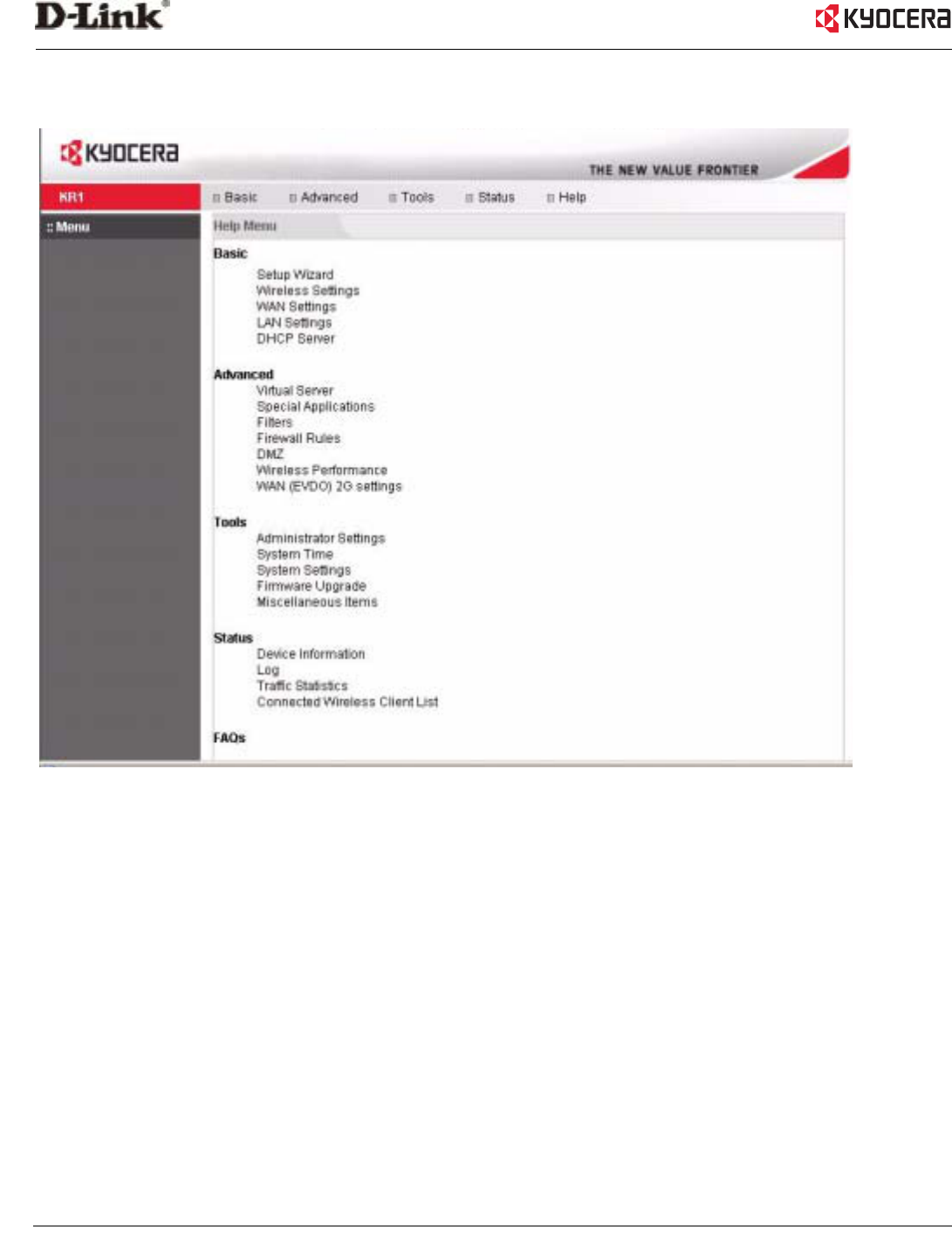
38 Kyocera KR1 Mobile Router User Guide
Help > Help Menu
Click on Help at any time, for more information.
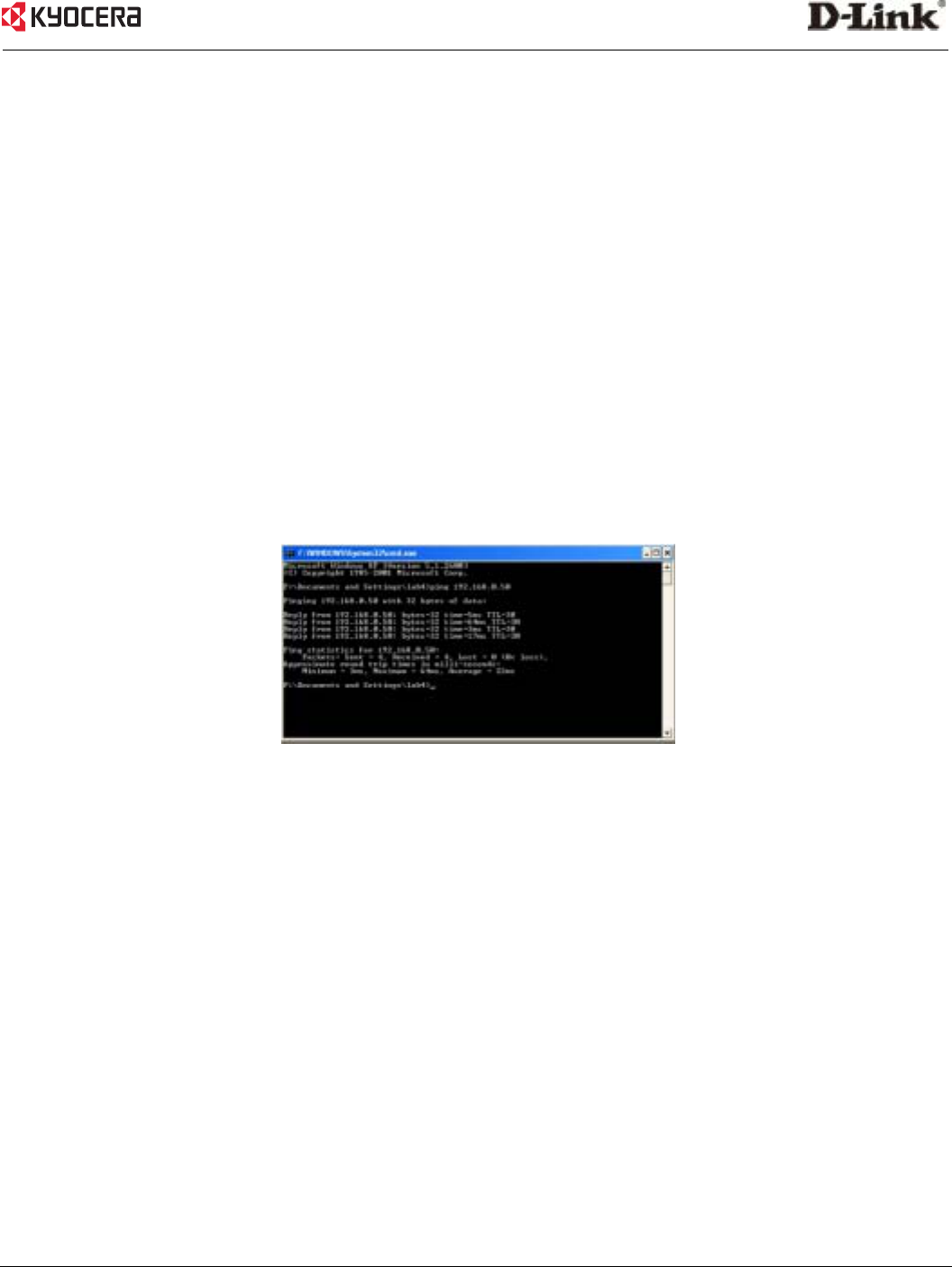
Troubleshooting 39
6 Troubleshooting
This section provides an overview of common issues, and possible solutions for the installation and operation of the
Kyocera KR1 Mobile Router.
1. I am unable to access the Configuration Menu when I use my computer to configure the router.
Why?
Note: It is recommended that you use an Ethernet connection to configure the Kyocera KR1 Mobile Router.
Ensure that the Ethernet LED on the Kyocera KR1 Mobile Router is ON.
If the LED is not ON, check to see if the cable for the Ethernet connection is securely inserted.
Note: Ensure that the IP Address is in the same range and subnet as the Kyocera KR1 Mobile Router.
The IP Address of the Kyocera KR1 Mobile Router is 192.168.0.1. All the computers on the network
must have a unique IP Address within the same range (e.g., 192.168.0.x). Any computers that have
identical IP Addresses will not be visible on the network. All computers must also have the same
subnet mask (e.g., 255.255.255.0).
Do a Ping test to make sure that the Kyocera KR1 Mobile Router is responding.
Go to Start > Run. Type cmd. Press Enter. Type ping 192.168.0.1. A successful ping shows four replies.
Note: If you have changed the default IP Address, ensure you ping the correct IP Address assigned to the
Kyocera KR1 Mobile Router.
Ensure that your Ethernet Adapter is working properly, and that all network drivers are installed properly.
Note: The network adapter name displayed below is provided as an example. Network adapter names will
vary depending on your specific adapter. The installation steps listed below are applicable for all
network adapters.
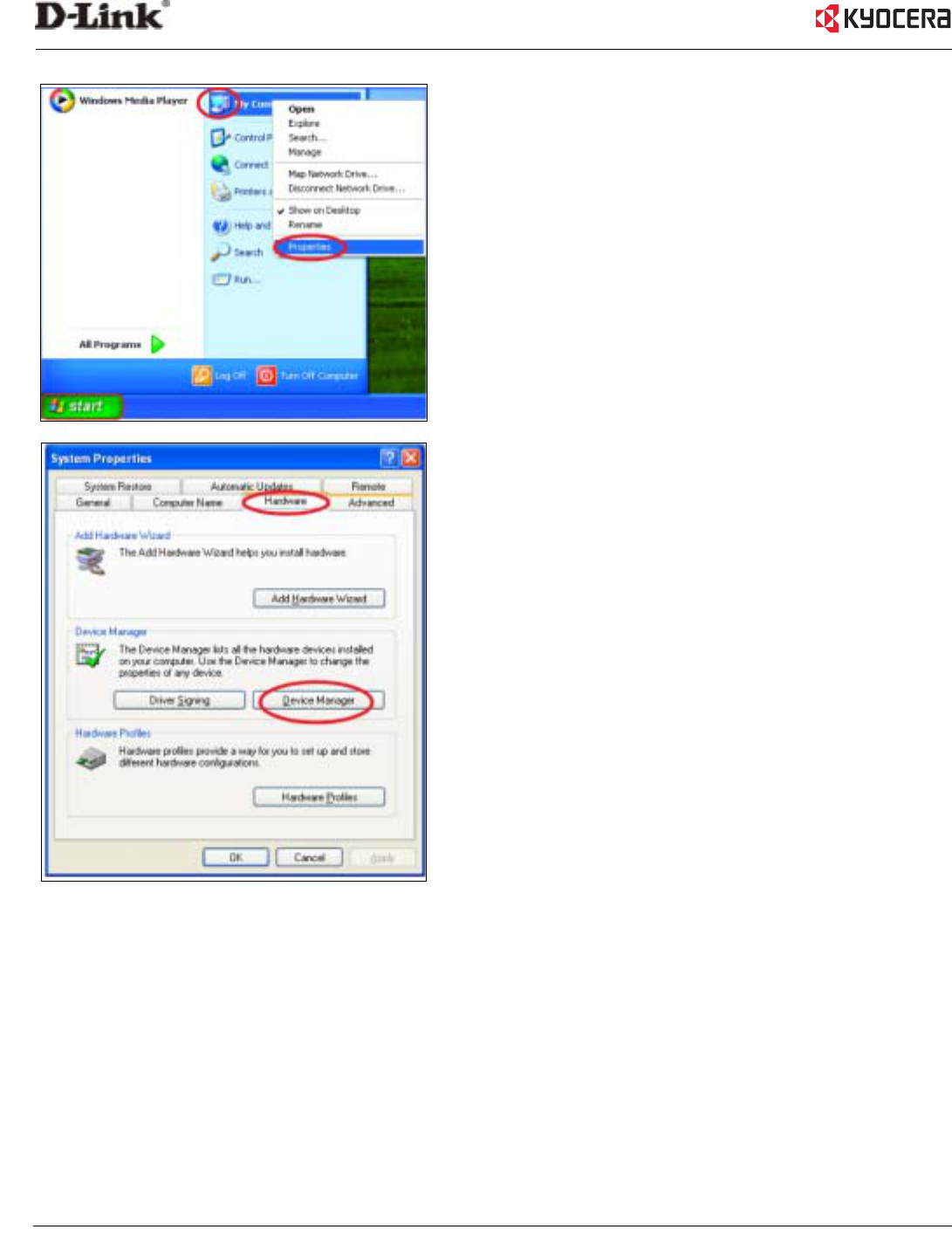
40 Kyocera KR1 Mobile Router User Guide
1. Go to Start > My Computer > Properties.
2. Select the Hardware Tab.
3. Click Device Manager.
4. Double-click on Network Adapters.
5. Right-click on D-Link AirPlus DWL-G650 Wireless Cardbus Adapter, or your specific network adapter.
6. Select Properties to ensure that all drivers are installed properly.
7. Look under Device Status to see if the device is
working properly.
8. Click OK.

Troubleshooting 41
2. My wireless client cannot access the Internet. What should I do?
Note: Establish WiFi Connection. If you selected either WEP or WPA-PSK encryption, ensure encryption settings
match your WiFi settings. WiFi and encryption settings must match to ensure Kyocera KR1 Mobile Router
Configuration Menu, and Internet access. Please refer to your WiFi adapter documentation for additional
information.
Ensure that the wireless client is associated and joined with the correct Access Point.
To check this connection, follow the steps below:
1. Right-click on the Local Area Connection icon in the taskbar.
2. Select View Available Wireless Networks. The Connect to Wireless Network screen appears.
Ensure you have selected the correct available network.
Ensure the IP Address assigned to the wireless adapter is within the same IP Address range as the Access Point and
gateway. The Kyocera KR1 Mobile Router has an IP Address of 192.168.0.1. Wireless adapters must have an IP Address
in the same range (e.g., 192.168.0.x). Although the subnet mask must be the same for all the computers on the
network, no two devices may have the same IP Address. Therefore, each device must have a unique IP Address.
To check the IP Address assigned to the wireless adapter, follow the steps below:
1. Double-click on the Local Area Connection icon in the taskbar.
2. Select the Support tab. The IP Address will be displayed.
3. What variables may cause my wireless products to lose reception?
The Kyocera KR1 Mobile Router will allow you to access your network from virtually anywhere in its coverage area,
however, its position within your environment will affect the wireless range
Note: Please see “Installation Considerations” on page 6, for additional information.
4. Why does my wireless connection keep dropping?
• Antenna Orientation. Try different antenna orientations for the Kyocera KR1 Mobile Router.
Try to keep the antenna at least 6 inches away from the wall or other objects.
• If you use 2.4GHz cordless phones, X-10 equipment, other home security systems, ceiling fans, or lights, your
wireless connection may degrade dramatically, or drop altogether.
Try changing the channel on the Kyocera KR1 Mobile Router, and your Access Point and Wireless adapter to a
different channel to avoid interference.
• Keep your product away (at least 3-6 feet) from electrical devices that generate RF noise,
like microwaves, monitors, electric motors, etc.

42 Kyocera KR1 Mobile Router User Guide
5. I am unable to achieve a wireless connection. Why?
Note: An Ethernet connection is required to troubleshoot the Kyocera KR1 Mobile Router.
If you have enabled Encryption on the Kyocera KR1 Mobile Router, you must also enable encryption on all wireless
clients in order to establish a wireless connection.
• For 802.11g, the encryption settings are: 64 or 128 bit. Ensure that the encryption bit level is the same for both
the Kyocera KR1 Mobile Router, and your Wireless Client.
• Ensure that the SSID (Service Set Identifier) on the Kyocera KR1 Mobile Router and the Wireless Client are exactly
the same.
If they are not, your wireless connection will not be established.
• Move the Kyocera KR1 Mobile Router and the wireless client into the same room, and then test the wireless
connection.
• Disable all security settings such as WEP, and MAC Address Control.
• Turn off the Kyocera KR1 Mobile Router and the client.
Turn the Kyocera KR1 Mobile Router back on again, and then turn on the client.
• Ensure that all devices are set to Infrastructure mode.
• Ensure that the LED indicators are indicating normal activity. If not, ensure that the AC power and Ethernet cables
are firmly connected.
• Ensure that the IP Address, subnet mask, gateway and DNS settings are correctly entered for the network.
• If you are using 2.4GHz cordless phones, X-10 equipment, or other home security systems, ceiling fans, or lights,
your wireless connection may degrade dramatically, or drop altogether.
To avoid interference, change the Channel on the Kyocera KR1 Mobile Router, and all devices in your network.
• Keep your product at least 3-6 feet away from electrical devices that generate RF noise. Examples include:
microwaves, monitors, electric motors, and so forth.
6. I forgot my encryption key. What should I do?
• If you forgot your encryption key, the WiFi card will be unable to establish a proper connection.
If an encryption key setting has been set for the Kyocera KR1 Mobile Router, it must also be set for the WiFi card
that will connect to the Kyocera KR1 Mobile Router.
To reset the encryption key(s), login to the Kyocera KR1 Mobile Router using a wired connection.
(Please refer to “Basic > Wireless (Security–No Encryption)” on page 10, for additional information).
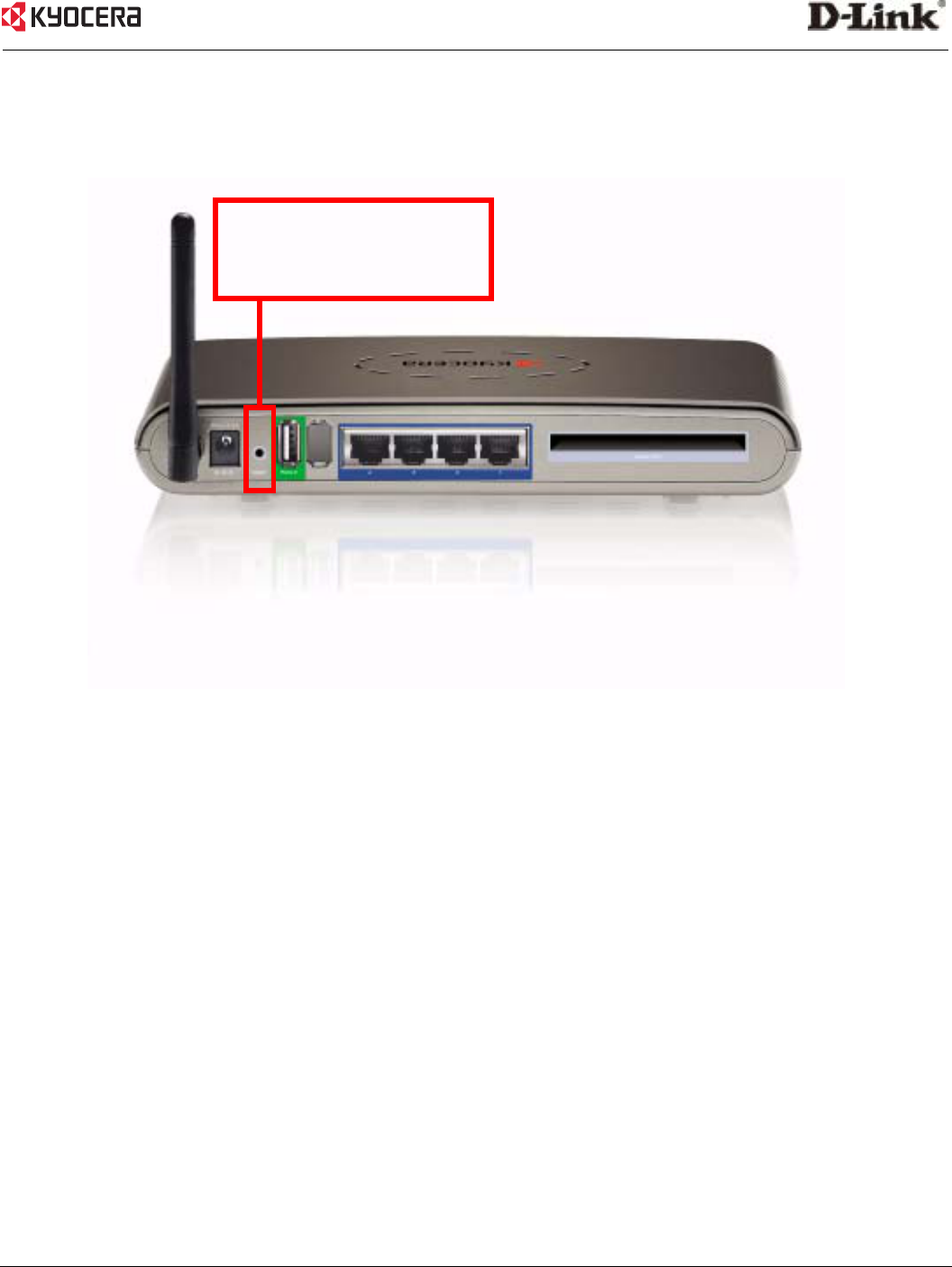
Troubleshooting 43
7. How do I reset my Kyocera KR1 Mobile Router to its factory default settings?
If other troubleshooting methods have failed, you may choose to Reset the Kyocera KR1 Mobile Router to its factory
default settings.
To hard-reset the Kyocera KR1 Mobile Router its factory default settings, follow the steps listed below:
1. Ensure the Kyocera KR1 Mobile Router is powered on
2. Locate the Reset button on the back of the Kyocera KR1 Mobile Router.
3. Use a paper clip to press the Reset button.
4. Hold for 10 seconds and then release.
5. After the Kyocera KR1 Mobile Router reboots, it is reset to the factory default settings.
Note: Please note that this process will take a few minutes.
8. What is VPN?
• VPN stands for “Virtual Private Networking.” VPNs create a "tunnel" through an existing Internet connection using
PPTP (Point-to-Point Tunneling Protocol) or IPSec (IP Security) protocols with various encryption schemes
including Microsoft Challenge Handshake Authentication Protocol (MS-CHAP) .
• This feature allows you to use your existing Internet connection to connect to a remote site with added security.
If your VPN connection is not functional, verify that your VPN dial-up configuration is correct.
Note: This information should be provided to you from your VPN provider.
Pressing the Reset Button
restores the KR1 to its
original factory default settings.

44 Kyocera KR1 Mobile Router User Guide
9. What can I do if my Ethernet cable does not work properly?
• First, ensure that there is a solid cable connection between the Ethernet port on the Kyocera KR1 Mobile Router,
and your NIC (Network Interface Card).
• Second, ensure that the settings on your NIC adapter are “Enabled,” and set to accept an IP address from the
DHCP.
• If settings appear to be correct, ensure that you are not using a crossover Ethernet cable. Although the Kyocera
KR1 Mobile Router is MDI/MDIX compatible, not all NICs are. Therefore, it is recommended that you use a patch
cable when possible.

Technical Support 45
7 Technical Support
Technical Support
D-Link provides free technical support for customers within the United States and within Canada for the warranty
period of one year on this product.
D-Link Technical Support over the Telephone (U.S.):
(888) 351-5353
D-Link Technical Support over the Internet:
http://support.dlink.com
When contacting technical support, please provide the following information:
Note: All numbers referenced below can be found on the bottom of the Kyocera KR1 Mobile Router.
• Model number or product name. This is the ten-digit “TX” number.
• Serial number of the unit.
• Date code
• Firmware version
Note: The firmware version can be found by logging into the router and viewing the status page. For more
information.
Kyocera Accessories
To shop for Kyocera KR1 Mobile Router accessories, visit http://www.kyocera-wireless.com/store.

46 Kyocera KR1 Mobile Router User Guide
8 Technical Specifications
Standards
• IEEE 802.11b/g
• IEEE 802.3
• IEEE 802.3u
VPN Pass Through/ Multi-Sessions
• PPTP
• IPSec
Device Management
• Web-Based- Internet Explorer v6 or later; Netscape Navigator v7 or later; or other Java-enabled browsers
• DHCP Server and Client
Advanced Firewall Features
• IP Filtering
•Scheduling
• NAT (Network Address Translation) with VPN Passthrough
• MAC Filtering
Wireless Operating Range
• Indoors - up to 328 feet (100 meters)
• Outdoors - up to 1312 feet (400 meters)
Operating Temperature
• 32ºF to 131ºF (0ºC to 55ºC)
Humidity:
• 95% maximum (non-condensing)
Safety and Emissions:
• FCC
Wireless Frequency Range:
• 2.4GHz to 2.462GHz
LEDs:
•Power
• Status
•WAN
• WLAN (Wireless Connection)
• LAN
• Phone
Physical Dimensions:
• L = 7.56 inches (192mm)
• W = 4.65 inches (118mm)
• H = 1.22 inches (31mm)
Wireless Transmit Power:
• 15dBm ± 2dB

Technical Specifications 47
Security:
• 802.11b/ 802.11g
• WPA- WiFi Protected Access (64-,128-WEP with Shared Key Authentication)
External Antenna Type:
• Single detachable reverse SMA
Modulation Technology:
• Orthogonal Frequency Division Multiplexing (OFDM)
Power Input:
• Ext. Power Supply DC 5V, 3.0A
Weight:
• 10.8 oz. (0.3kg)
Wa rr an ty :
• 1 year
Wireless Data Rates with Automatic Fallback:
•54 Mbps
• 48 Mbps
• 36 Mbps
• 24 Mbps
• 18 Mbps
• 12 Mbps
• 11 Mbps
• 9 Mbps
• 6 Mbps
• 5.5 Mbps
• 2 Mbps
• 1 Mbps

48 Kyocera KR1 Mobile Router User Guide
9 Consumer Limited Warranty (USA only)
Kyocera Wireless Corp. (“KYOCERA”) offers you a limited warranty that the enclosed product or products (the “Product”) will be free from defects in material and workmanship for a period that expires one year
from the date of sale of the Product to you, provided that you are the original end-user purchaser of the Product and provided that your purchase was made from an authorized supplier. Transfer or resale of a
Product will automatically terminate warranty coverage with respect to that Product. This limited warranty is not transferable to any third party, including but not limited to any subsequent purchaser or owner of
the Product. This limited warranty is applicable only to end users in the United States and Canada.
KYOCERA shall, at its sole and absolute discretion, either repair or replace a Product (which unit may use refurbished parts of similar quality and functionality) if found by KYOCERA to be defective in material or
workmanship, or if KYOCERA determines that it is unable to repair or replace such Product, KYOCERA shall refund the purchase price for such Product, provided that the subject Product (i) is returned, with
transportation prepaid, to a KYOCERA authorized service center within the one year warranty period, and (ii) is accompanied by a proof of purchase in the form of a bill of sale or receipted invoice which
evidences that the subject Product is within the one year warranty period (“Proof of Purchase”). After the one year warranty period, you must pay all shipping, parts and labor charges.
This limited warranty does not cover and is void with respect to the following: (i) any Product which has been improperly installed, repaired, maintained or modified; (ii) any Product which has been subjected
to misuse (including any Product used in conjunction with hardware electrically or mechanically incompatible or used with accessories not approved by KYOCERA), abuse, accident, physical damage, abnormal
operation, improper handling, neglect, exposure to fire, water or excessive moisture or dampness or extreme changes in climate or temperature; (iii) any Product operated outside published maximum ratings;
(iv) cosmetic damage; (v) any Product on which warranty stickers or Product serial numbers have been removed, altered, or rendered illegible; (vi) cost of installation, removal or reinstallation; (vii) signal
reception problems (unless caused by defects in material and workmanship); (viii) damage the result of fire, flood, acts of God or other acts which are not the fault of KYOCERA and which the Product is not
specified to tolerate, including damage caused by mishandling, shipping and blown fuses; (ix) consumables (such as fuses); or (x) any Product which has been opened, repaired, modified or altered by anyone
other than KYOCERA or a KYOCERA authorized service center.
USE ONLY KYOCERA APPROVED ACCESSORIES WITH KYOCERA PHONES. USE OF ANY UNAUTHORIZED ACCESSORIES MAY BE DANGEROUS AND WILL INVALIDATE THE PHONE WARRANTY IF SAID ACCESSORIES
CAUSE DAMAGE OR A DEFECT TO THE PHONE.
KYOCERA SPECIFICALLY DISCLAIMS LIABILITY FOR ANY AND ALL DIRECT, INDIRECT, SPECIAL, GENERAL, PUNITIVE, EXEMPLARY, AGGRAVATED, INCIDENTAL OR CONSEQUENTIAL DAMAGES, EVEN IF ADVISED
OF THE POSSIBILITY THEREOF, WHETHER FORESEEABLE OR UNFORESEEABLE OF ANY KIND WHATSOEVER, INCLUDING BUT NOT LIMITED TO LOSS OF PROFITS, UNANTICIPATED BENEFITS OR REVENUE,
ANTICIPATED PROFITS ARISING OUT OF USE OF OR INABILITY TO USE ANY PRODUCT (FOR EXAMPLE, WASTED AIRTIME CHARGES DUE TO THE MALFUNCTION OF A PRODUCT) OR CONTRIBUTION OR
INDEMNITY IN RESPECT OF ANY CLAIM RELATED TO A PRODUCT.
REPAIR OR REPLACEMENT OF A DEFECTIVE PRODUCT OR REFUND OF THE PURCHASE PRICE RELATING TO A DEFECTIVE PRODUCT, AS PROVIDED UNDER THIS WARRANTY, ARE YOUR SOLE AND EXCLUSIVE
REMEDIES FOR BREACH OF THE LIMITED WARRANTY, AND SUBJECT TO THIS WARRANTY, THE PRODUCTS ARE APPROVED AND ACCEPTED BY YOU “AS IS”. KYOCERA MAKES NO OTHER WARRANTIES,
REPRESENTATIONS OR CONDITIONS OF ANY KIND, ORAL OR VERBAL, EXPRESS OR IMPLIED, STATUTORY OR OTHERWISE, WITH RESPECT TO THE PRODUCTS, INCLUDING BUT NOT LIMITED TO ANY IMPLIED
WARRANTY OR CONDITION OF MERCHANTABILITY OR FITNESS FOR A PARTICULAR PURPOSE OR AGAINST INFRINGEMENT OR ANY IMPLIED WARRANTY OR CONDITION ARISING OUT OF TRADE USAGE OR OUT
OF A COURSE OF DEALING OR COURSE OF PERFORMANCE. NO DEALER, DISTRIBUTOR, AGENT OR EMPLOYEE IS AUTHORIZED TO MAKE ANY MODIFICATION OR ADDITION TO THIS WARRANTY.
Some jurisdictions do not allow the exclusion or limitation of incidental or consequential damages, or allow limitations on how long an implied warranty lasts, so the above limitations or exclusions may not apply
to you. This limited warranty gives you specific legal rights, and you may also have other rights which vary from jurisdiction to jurisdiction.
For warranty service information, please call the following telephone number from anywhere in the continental United States and Canada: 1-800-349-4478 or 858-882-1401; or contact KYOCERA at the following
address: 10300 Campus Point Drive, San Diego, California, 92121-1582, USA, Attention: Technical Support.
DO NOT RETURN YOUR PRODUCTS TO THE ABOVE ADDRESS. Please call or write for the location of the Kyocera Wireless Corp. authorized service center nearest you and for procedures for obtaining
warranty service.